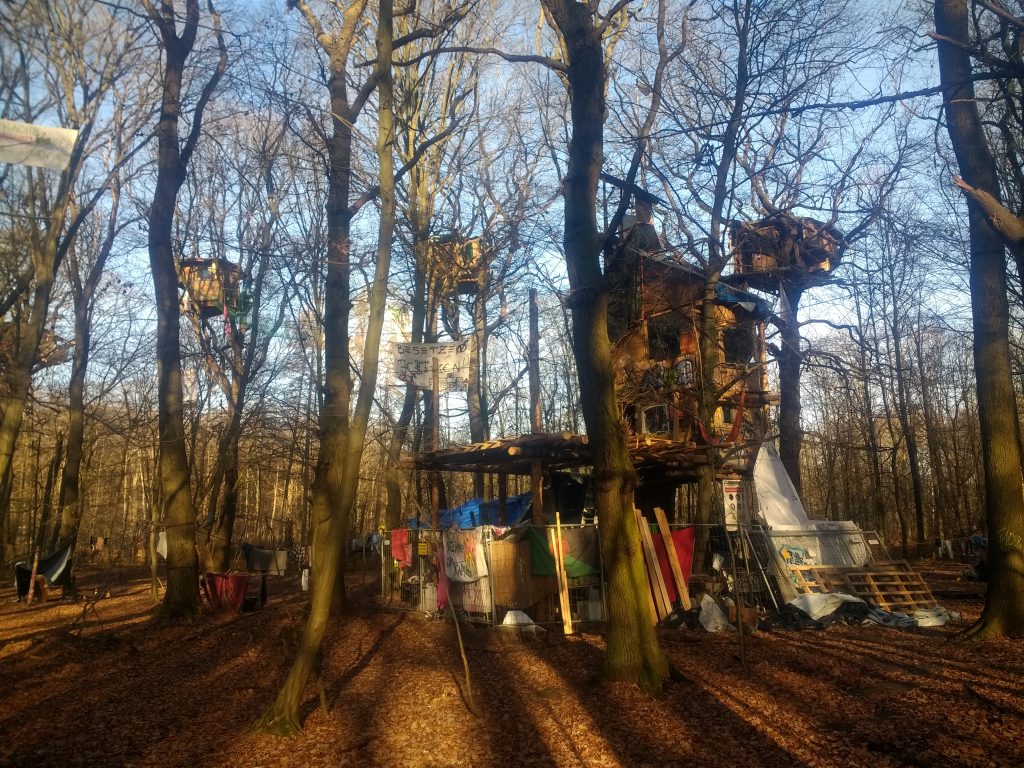
Many of the projects I have visited up until now have been sites of construction. People trying to erect alternative, ethical ways of life so that they no longer have to rely on violent global structures. But social transformation is not only an act of constructive. Those who are currently benefiting from the system will not simply allow this system to fall. Specifically, those who are currently profiting from the industrial consumer society are not going to simply give up their campaign of mass exploitation when they see an alternative mode of living. If the story of human history has taught us anything, it is that those in positions of power do everything they can to maintain their position. On the one hand the ego longs after sensual pleasure and social status, and doesn’t abide by the relinquishment of wealth. On the other, fear stalks power as its shadow. Those who built an empire of death and destruction fear retribution from the survivors. For these reasons, resistance is an essential part of any social transformation. Without construction resistance is empty, not being able to offer anything in its place (which has been the problem of progressive politics during the 90’s, 00’s). Without resistance construction will simply be rolled over by the train of business-as-usual. It is for this reason that Hambacher Wald has become such an important site of social transformation in the last number of years.
Living in the city,
I was comfortable,
but grew restless in pursuit of pleasure,
Now I go into the forest,
wanting to be in the cold.
Living from the generosity of strangers,
and what others have thrown away,
I gratefully take what I am given.
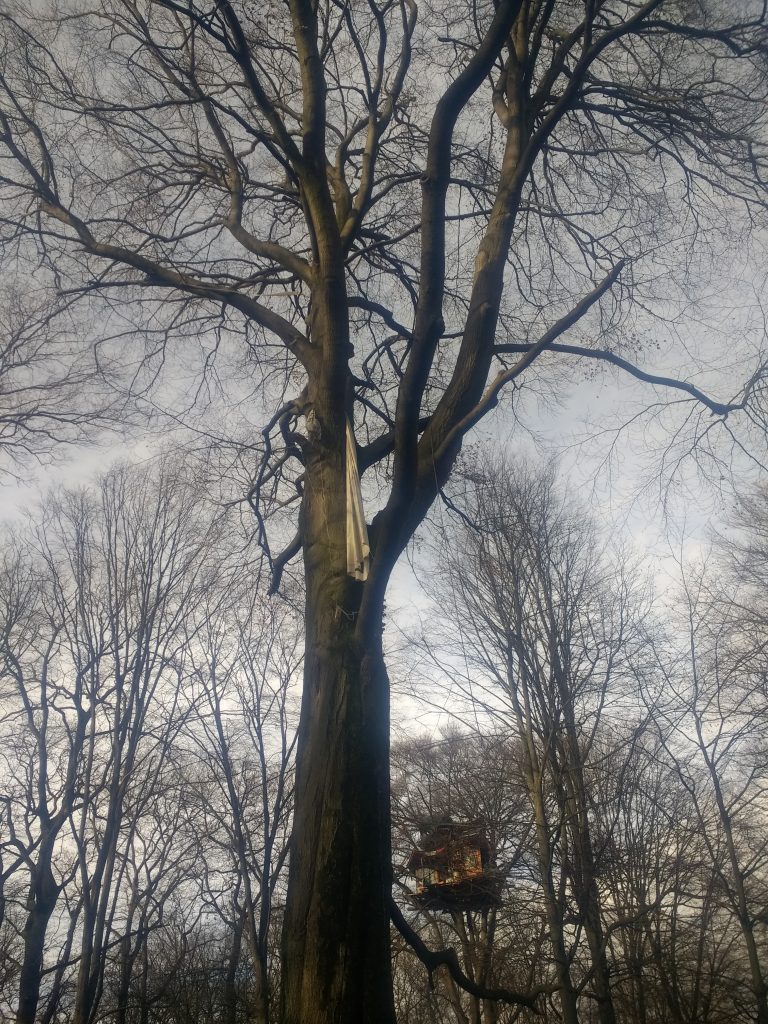
History
The Hambacher Wald is one of the oldest in Europe, going back to the end of the ice age in Europe, 12,000 years ago. The earliest human stories we have of what is now known as the Hambacher Forst go back about 1200 years to the times of the first Holy Roman emperor, Charlemagne. The forest was also at that time under dispute. The the newly anointed emperor declared the forest his own personal property, and barred the people of the surrounding villages from entering. Without access to the resources of the forest, the poor farmers of the villages suffered. Dismayed at the plight of the people, Arnold von Arnoldsweiler, a musician in the court of Charlemagne’s, decided to help. At the start of a celebratory feast Arnold told Charlemagne that he was ready to settle down, and asked Charlemagne to gift him all of the lands that he could encircle during the length of the feast. Now, although feasts went on for several days in those times, Charlemagne granted the favour of his favourite court musician. After all, how much distance could Arnold really cover in a couple of days? The answer, as you may have guessed, was the entirety of the forest. Yes, with a little help from the plucky villagers, providing him with a fresh horse each leg of the way, Arnold von Arnoldweiler managed to circumnavigate the entirety of the forest, marking every leg of his journey with a little black flag, imprinted with a red A (or so the legend is told in the forest at least). Arnold gifted the forest to the people, and for the next thousand years the forest was Bürgewald, common land, the property of no one in particular.

This was the situation until until the end of the 1960’s, when the regional government of Nord Rhein Westphalen decided that the forest was theirs, and promptly sold it to the energy corporation Rheinisch-Westfälisches Elektrizitätswerk (RWE). Upon acquisition RWE began levelling the forest, evicting the surrounding villagers, and tearing into the earth in search of coal. This campaign of mass destruction and displacement naturally provoked campaigns of resistance. The Hambacher Gruppe formed in 1978 to challenge RWE, but to little effect. In 1988 a local priest, Dieter Schmitteneinen, tried to rouse parishioners with a mass entitled Im Norden schreit die Erde (In the north the earth screams), a mass that was stormed by RWE workers. In 2004 Greenpeace held a protest the in forest, but again to little avail. The destruction of the forest, the expansion of the coal mine, steamrolled on. In 2012, with four fifths of the forest already destroyed it was clear that the time for protest and appeal was over. If what was left of the forest was to be saved, more drastic measures would have to be taken. A band of self described eco-anarchists began occupying the forest, putting their bodies between it and machines of mass destruction.

Space Surrounding
The occupation of the Hambacher Forst begins in the surrounding area. Before even reaching the forest you find different settlements constructed by the occupiers. The first site of occupation is the Mannwache, a small settlement on the side of road before the forest. The Mannwache is registered as a long term form of protest and thus the only part of the occupation that has legal permission to be there. It functions as a communal space for all of the occupiers, a meeting point with the outside world, as well as having a kitchen, and electricity to charge your devices. It was here that I first arrived and introduced myself to a couple of people who were there at the time, telling them I was new to the forest and asking where I stay. After a short moment of uncertainty and looking at each other from the corner of their eyes, a couple of told me they were on their way back to their camp and they would show me around the forest, eventually taking me to their camp where I could stay.
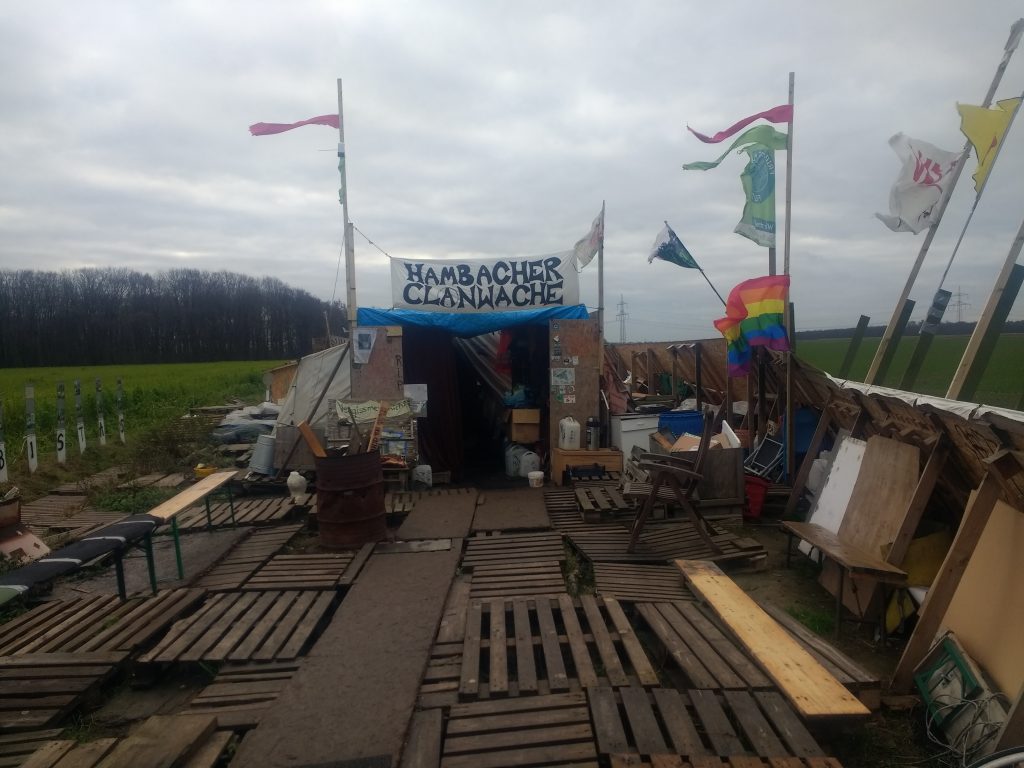
Chilling in the Mannwache is the best way to see how many people in the surrounding area come to support the action. In a few hours sitting in the communal tent there will invariably be a handful of ‘supporties’ stopping by to bring all the essentials of life; food, toilet paper, soap, bin bags, building materials, clothes. One person calls by to drop a few car loads of winter gear (boots, jackets, pants), excess from a military clothing shop. Another day, one person arrived in floods of tears, being received with a hug from one of the activists. She explained that she comes from the nearby town of Morschenich, where construction was taking place to destroy another part of the town to lay a pipeline leading toward the mine. Morschenich is one of seven villages where RWE has been buying up houses and displacing people who have lived there for generations. Today it is a little more than a ghost town. Where there was once people out on the streets, children playing, there is now boarded up houses, empty plots, and areas where RWE store some of their heavy machinery. There are some people living there, unwilling to give up on their ancestral homes, but their lives are now a constant struggle against the giants of industrial capitalism. Many of the those stayed behind become sick, probably a result of the poison from the coal factory spewed out into the air, water and land. Cancer rates much higher than average, although this is a topic the villagers don’t want to talk about. The women tells us that the part that they are now pulling up is a spot where kids have played since at least her father time.
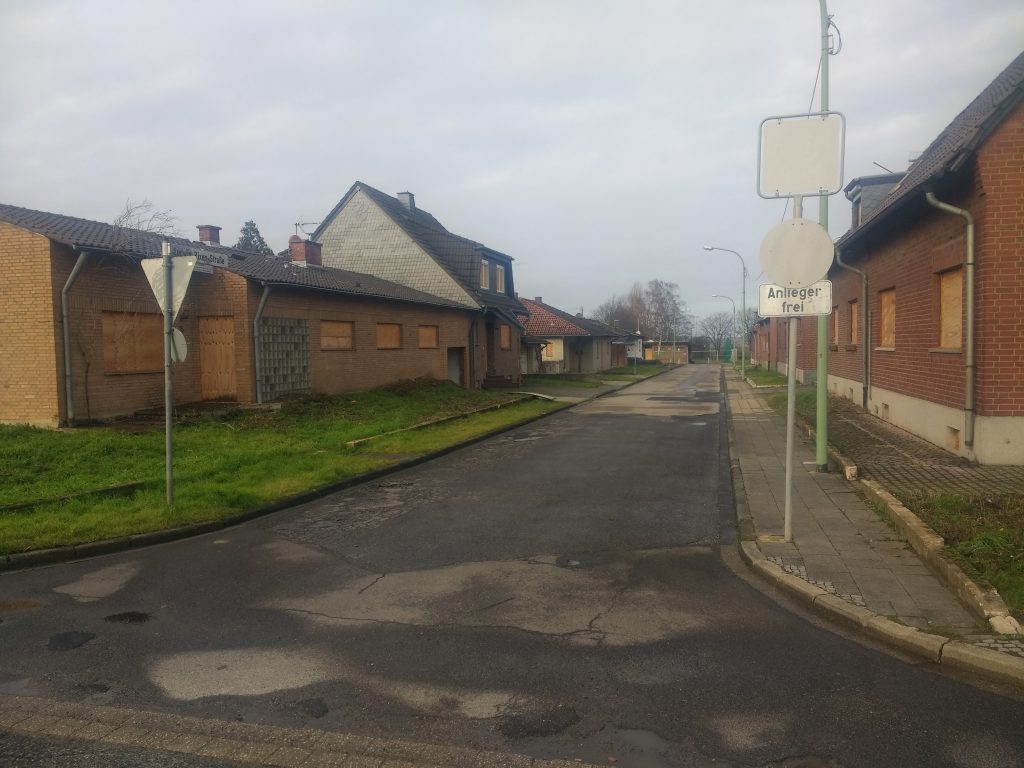
In the next town over, Mannheim, RWE had a strategy of turning the villagers against each other. In the past there were no fences between the houses. It was not a just place that people lived. It was a community. Over the past few decades, RWE implemented a strategy of turning the villagers against each other. Offering some very good contracts to sell parts of their land, while offering others worse. Haven taken over most of the land and economy of the region, they are also naturally large employers. Turning many of those who weren’t evicted into employees made them dependent on the company to live. This, along long with a tireless propaganda campaign (sponsoring the local football team, ads, etc.), has meant that they find support from some of the local people. This has created huge divisions between those who are for and those who are against the mine. Where once there was a community, there are now walls separating people from their neighbours.
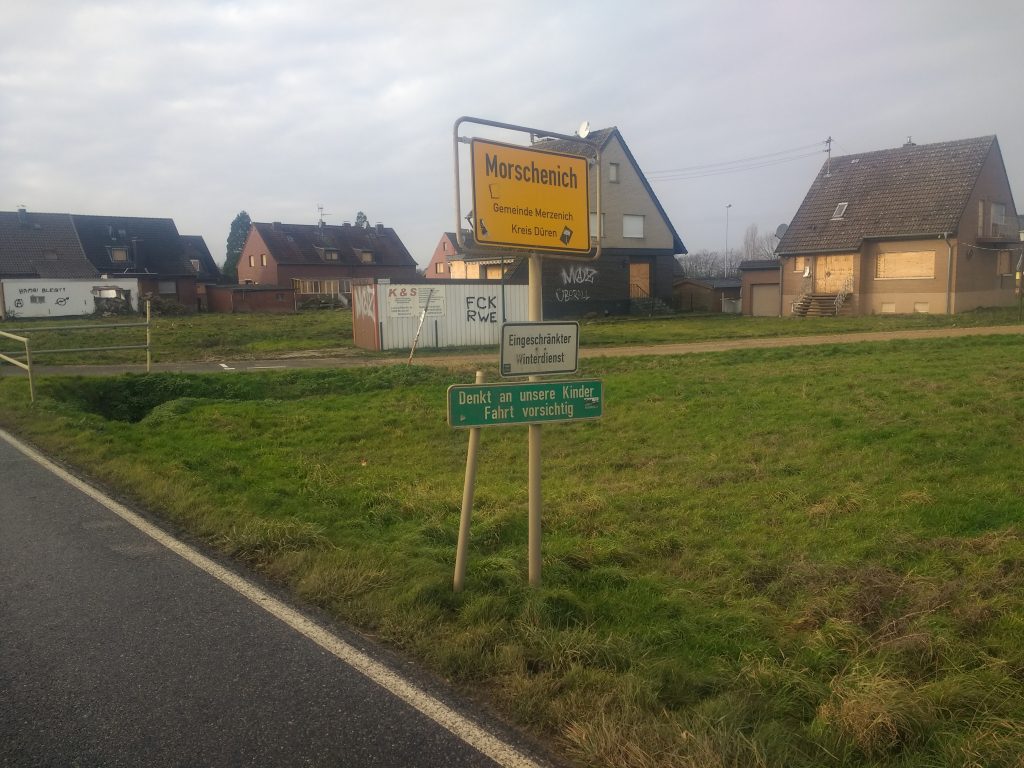
Another of the settlements outside the forest is die Wiese (the meadow). This is a more built up area in a field at the edge of the forest. With a roundhouse, communal kitchen, underground bunker, and clay house, there is plenty of space for community gathering. When I arrived during the skill share week this is where most of the workshops took place, and it often hosts community events; political talks, plenums, film evenings. The field itself belongs to a local farmer who supports the occupation, but this supporter has not had an easy time of it. During the last few years there have been many court cases to try and force the farmer to evict these people. At the time of writing the latest is that he lost the court case, and there will be an eviction of the Wiese, but as yet nothing has happened. The final settlement outside of the forest is Hambi Camp, a settlement of mainly of tents in the the town of Morshenich, functioning in a similar way to the Mannwache but a little bit bigger and more out of the way.
Forest Space
The forest is beautiful, with many trees that are hundreds of years. The dominant species are oak and hornbeam trees, but there are also many birch, beach, hazel, spruce, and ash trees. Accompanying them are a huge diversity of herbs (with the forest being particularly known for its abundance of lily of the valleys) and many types of animals – deer, boar, foxes, hares, and all different kinds of birds. But the forest is also sick. Nine tenths has already been destroyed, sacrificed for our unending appetite for coal. The coal mines and factories that were erected in its place have been slowly poisoning the landscape with its industrial waste for years. On top of the pollution, RWE has also been slowly draining the water from underneath the forest in preparation for the expansion of the mine.
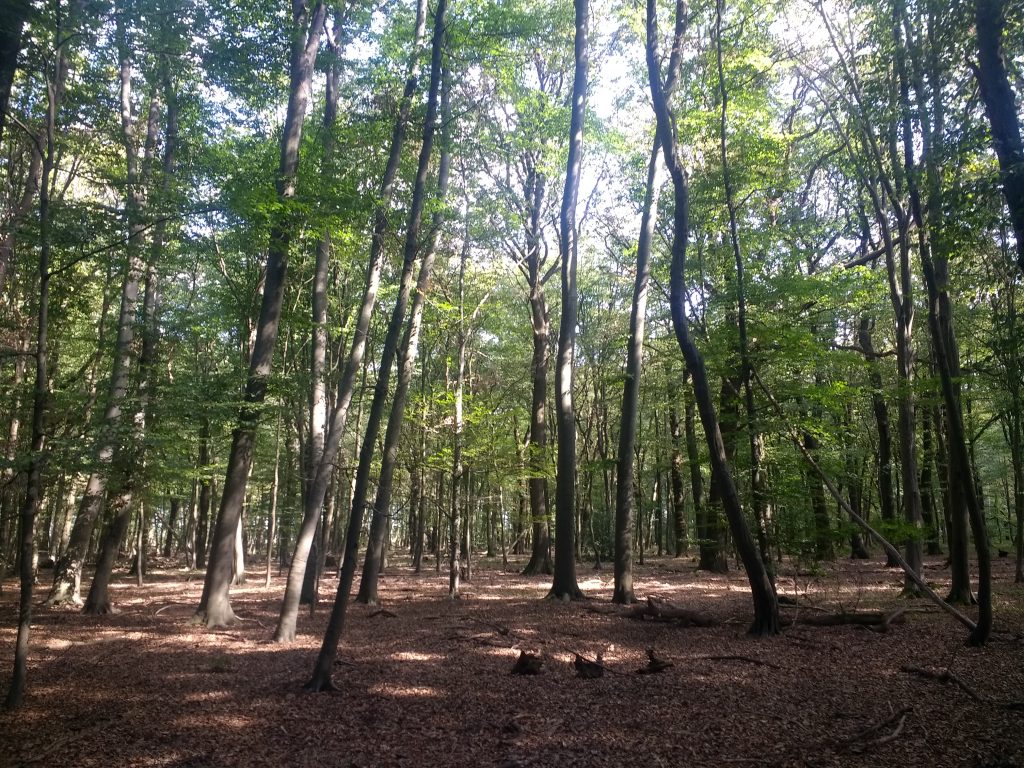
You enter the forest on paths once paved by RWE so they could navigate and drive through the forest with heavy machinery. These are now the roadways that activists and locals use to traverse the woodland. Large and elaborate barricades ensure that no more heavy machinery can make it into the forest. Instead you see people along the tracks, some with masks to conceal their identity, some local people interested in the occupation, or simply dog walkers. Sometimes you reach a cross roads with information points, where events are posted, or signposts leading you to some of the various camps.
Keep following the paths and you will begin to find some of the various forest settlements (barrios) that make up the bulwark of the occupation. There is no central point of occupation but a variety of different camps in different parts of the forest. Walking, it takes a couple of hours to get from one end of the occupation of the other. As one would expect, there is quite a large variety between the different barrios. Some exist mainly up high in the trees, some are composed ground structures, heavily fortified like medieval towns. Generally the camps are a mix of both. I’m not sure exactly how many barrios are currently in the forest but the number lies somewhere because ten and twenty. The number is constantly changing, as is the number of people occupying the forest. While there is always around one or two hundred people, there are usually a lot more in summer than in the winter.
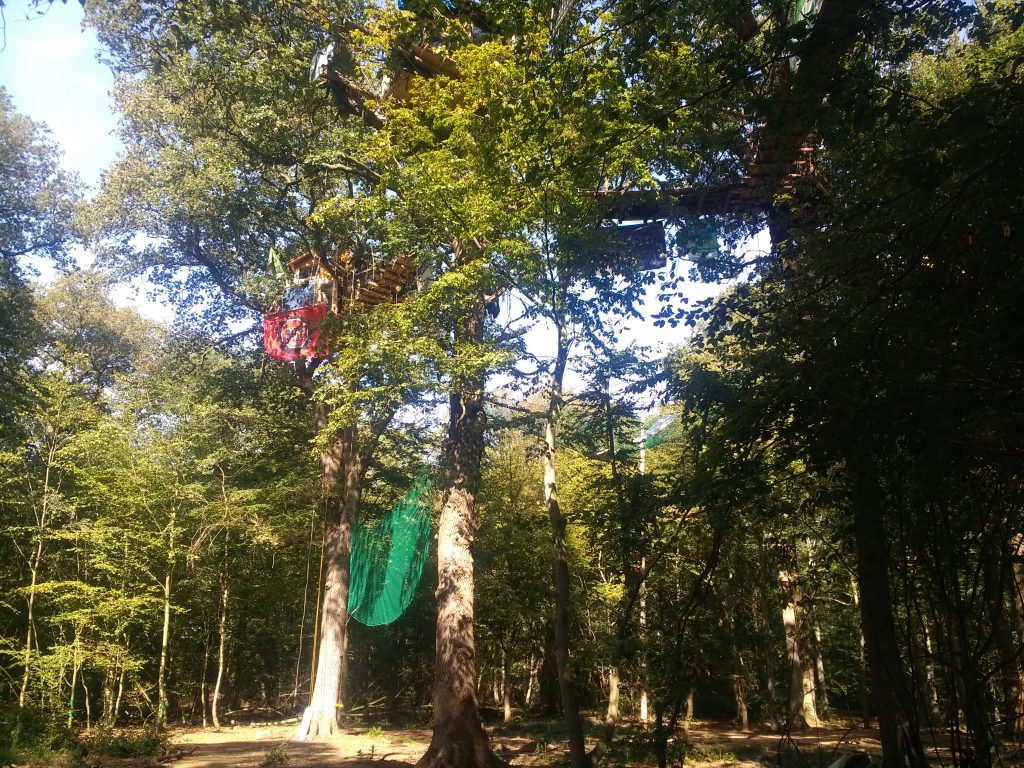
Like many human settlements before the modern era, the barrios are built strategically, with a mind on defensive capabilities in case of invasion. The settlements are illegal and police will come and attempt to destroy them. To defend the settlements, activists have two possibilities. The first is to build high in the trees, where it is hard to reach. To get a group of uncooperative people out of a well fortified structure, 40 meters high, deep in the forest, while ensuring everyone’s safety is as complicated an operation as it sounds. The other is the medieval method; build high, well fortified barriers. Some of the wall and barrier systems are such a complex mass of metal and wood that they would take days to clear without help from heavy machinery. While both these defensive settlements would ultimately fall to a police force with sufficient time and resources, they would be large expensive operations. Operation that local police forces generally aren’t equipt for.
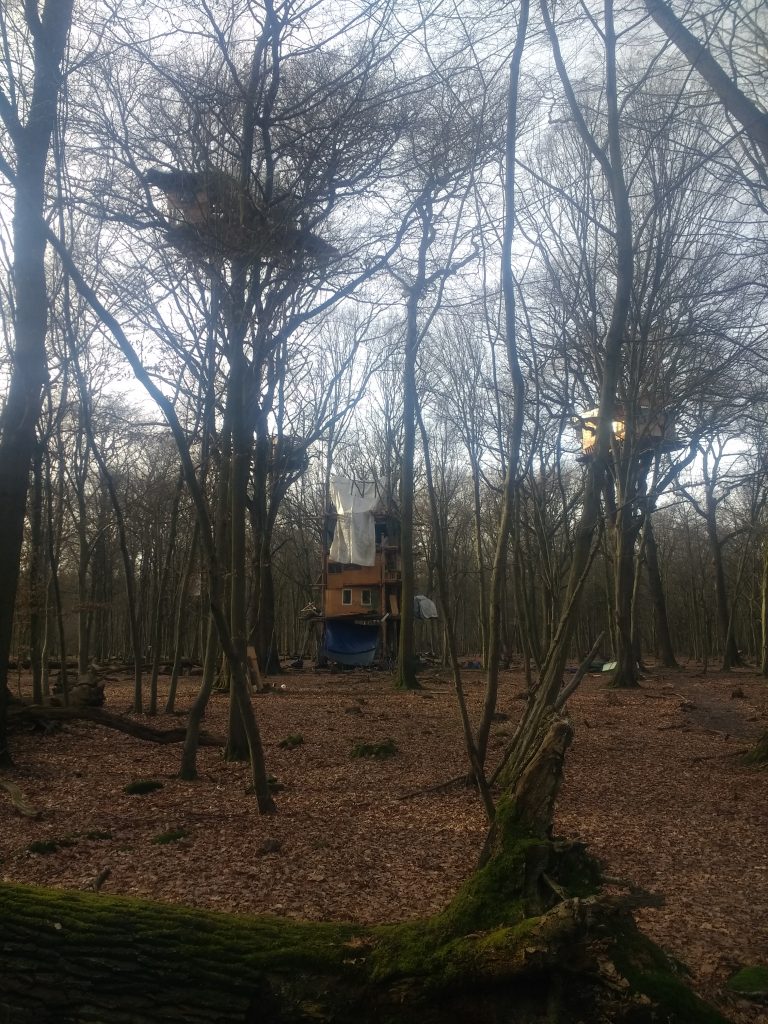
Most barrios are a mix of both fortified ground structures and tree houses. Generally the scheme for a settlement is one ‘tower’, a large fortified building which is accessible from the ground, connected with a network of treehouses. The treehouses can generally be accessed from either a rope going to the ground, or a network of walkways going between the tower and treehouses. Both access points are retractable in the case of police action. Aside from defensive considerations, every settlement is equipt with all of the normal requirements of human settlement; kitchens, washing stations, toilets (compost toilets at the edge of the settlement), places to sleep, places to store food, places to store equipment, a fire pit. Some of the settlements are kept very clean and orderly, some have the post-apocalyptic aesthetic of mad max (defensive fortresses built from the scraps of a fallen civilisation) but most of the settlements are a marvel to behold. Large, comfortable, often two story houses, high in the trees, or a four story of tower with over 60 squared meters. When one thinks that many of these houses had to be built under the pressure of police acts of repression, one marvels at the human capacity for creativity.
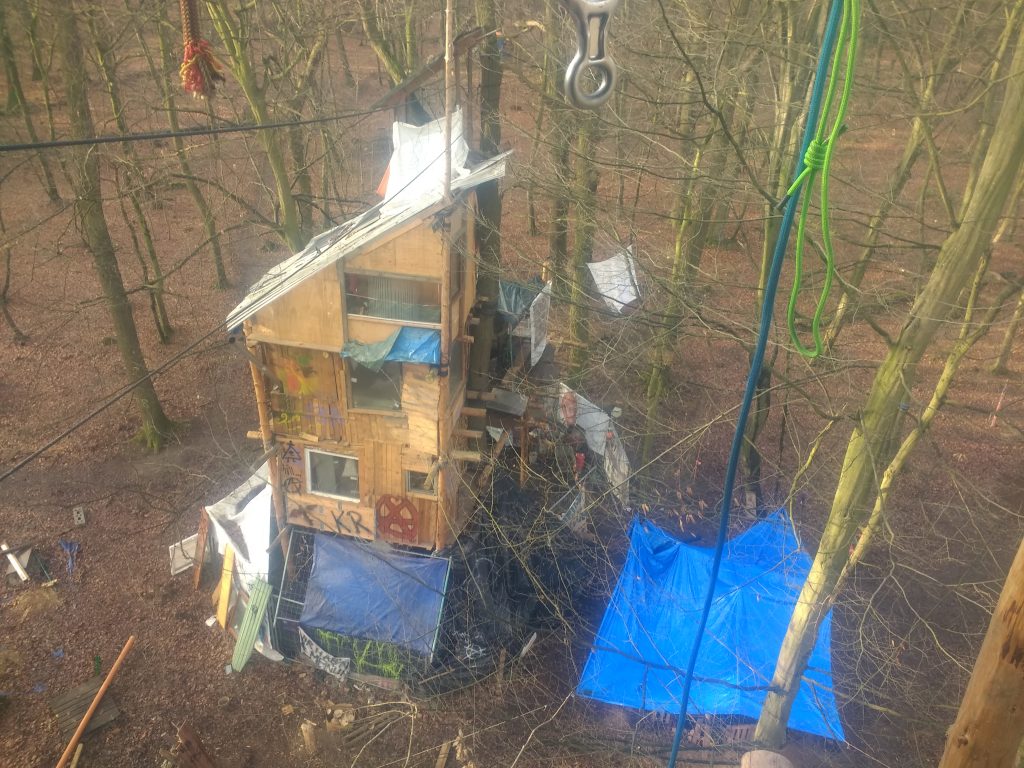
Spatially the camps are divided between east and west. In the west the two major barrios are Hazelnut and Anarch. Hazelnut is a very pretty barrio. The treehouses are well finished and connected by an impressive enclosed wooden bridges, as opposed to the usual rope walkways. The camp is also noticeable tidier and more orderly than a lot of the other camps. Both camps in the west are closer to the mine, the noise of the Bagger (excavator) is loud during the day and the spotlights shine into the camps at night. But Anarch is truly at the spearhead of the occupation in a little corner of the forest, jutting out toward the pit. Unlike the barrios of the east, which have enough forest between them and the mine, the Bagger is an ever present force.
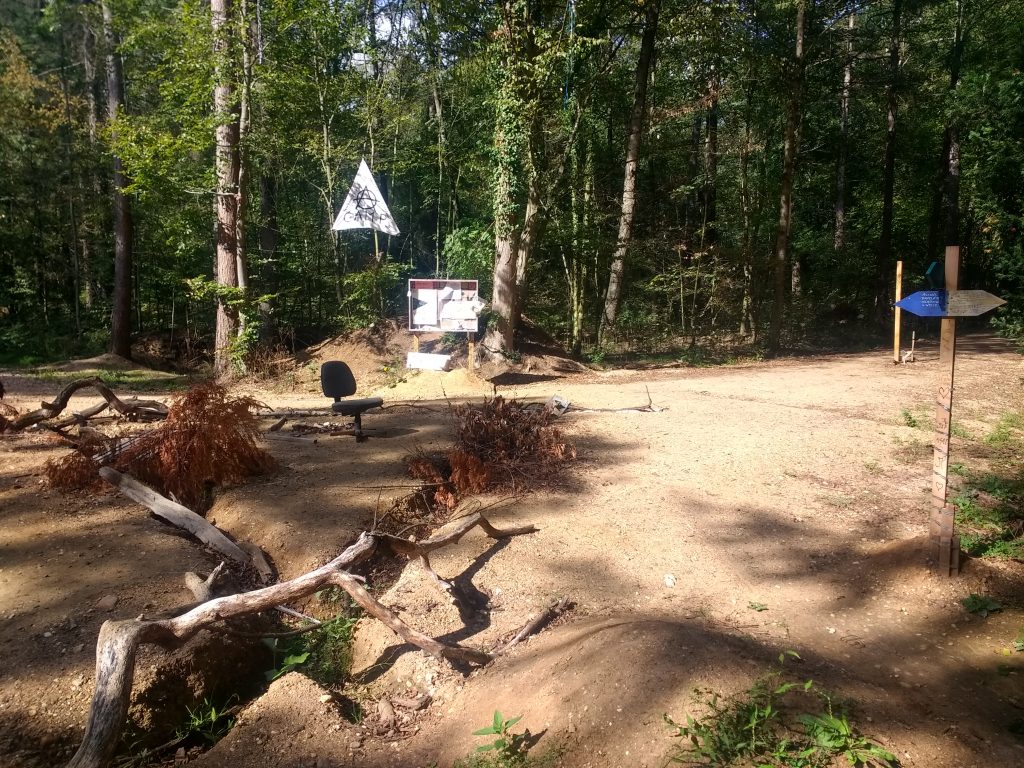
Walking east from Jesus Point (the central crossroad of the occupation) the two biggest camps are Lluna and Oak town. Both are large barrios, in relatively open spaces, with very impressive structures. Lluna with its four story tower (five if you include the open ground space), and Oak town with its beautiful network of treehouses. Further to the east, in an area that has only been occupied since the rebuilding action in October of 2018, is Endor and then Krähen Nest. Endor is a camp mainly consisting of ground structures, that, for reasons not entirely clear to me, has fallen into disrepair. And right in the furtherst eastern point of the forest, beside the old Autobahn that they had to rebuild because of the mine, is Krähen Nest (crows nest) the camp where I was staying. These are only some of the main barrios. They are many others, as well as individual tree houses or other types of smaller settlement.
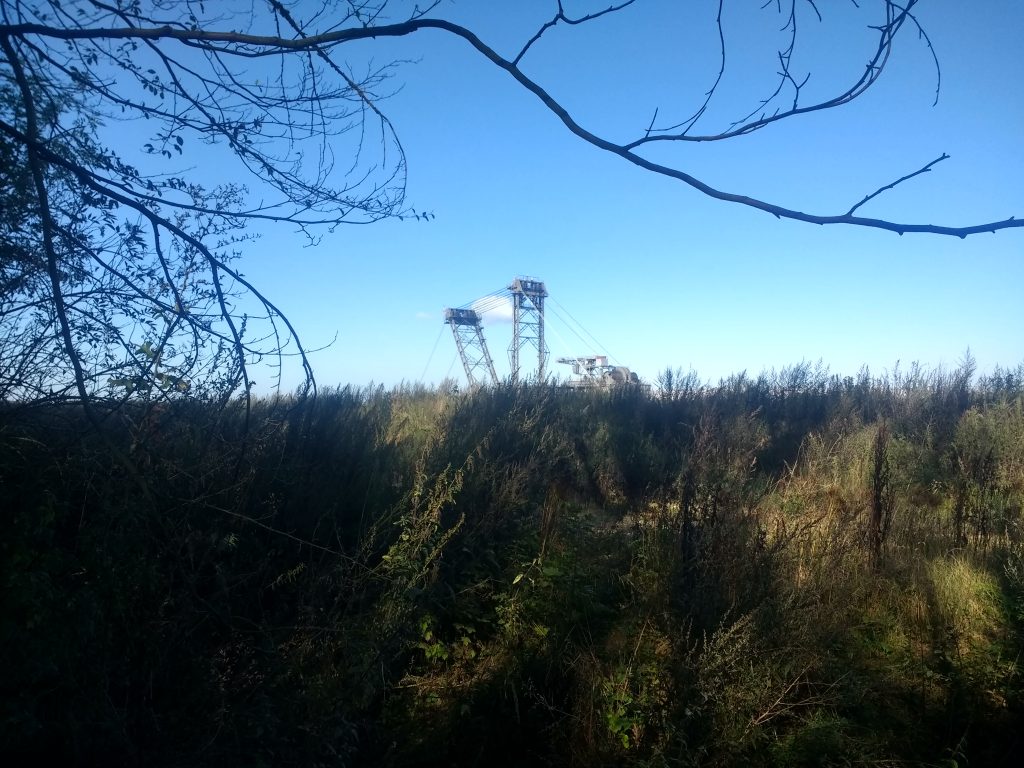
Right at the edge of the forest is the reason why people are here – the huge open cast mine. Going up to the precipice gives you an idea of the huge scale of the death and destruction that has already gone on here. Nine tenths of the forest has already been destroyed. In its place is a dusty crater being picked over by the Baggers. These gigantic monstrosities are the heaviest land machines in the world. The largest land machines in the world, the Overburden Conveyor Bridge F60, can also been seen in this vast scar on the surface of the earth. These machines are so energy intensive that 30% of the energy produced by the mine goes into its own operation. Factor in the inefficiency of the coal itself, and the waste of this whole operation boggles the mind. In winter, without the insulation of the leaves, the eerie drone of the heavy machinery is constant. You hear a lot about the environmental destruction of industrial society but its rare to experience it so viscerally as at the open cast mine. I was told that on the other side of the mine RWE have a little presentation centre. Here you can learn about how important RWE is, and how great the mine is. They even have a café with a panoramic view of the pit, so one can admire the amazing work done by RWE. The café is called Terra Nova, New World.
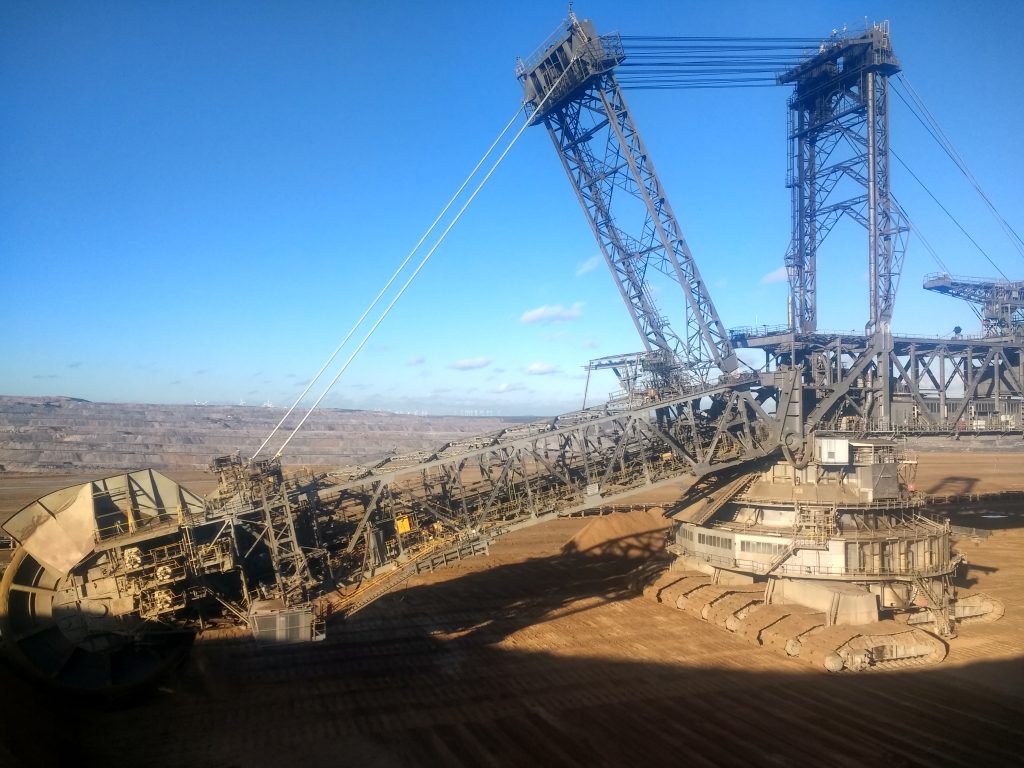
Police
Along with the mine and the activists, the forces of order also have a presence in this forest. Police and private security guards, employed by RWE, patrol around the perimeter, and some parts of the forest that the activists are not occupying. ‘Secu point’ is the security forces base of operations. Here they store their cars and organise themselves. At night the ‘secus’ illuminate the long ‘secu road’ that cuts the forest from the near east to the far east (where Endor and Krähen Nest are located), with blinding spotlights, and during times of increased activity they show their presence on this road. But most of the time it remains is quite.
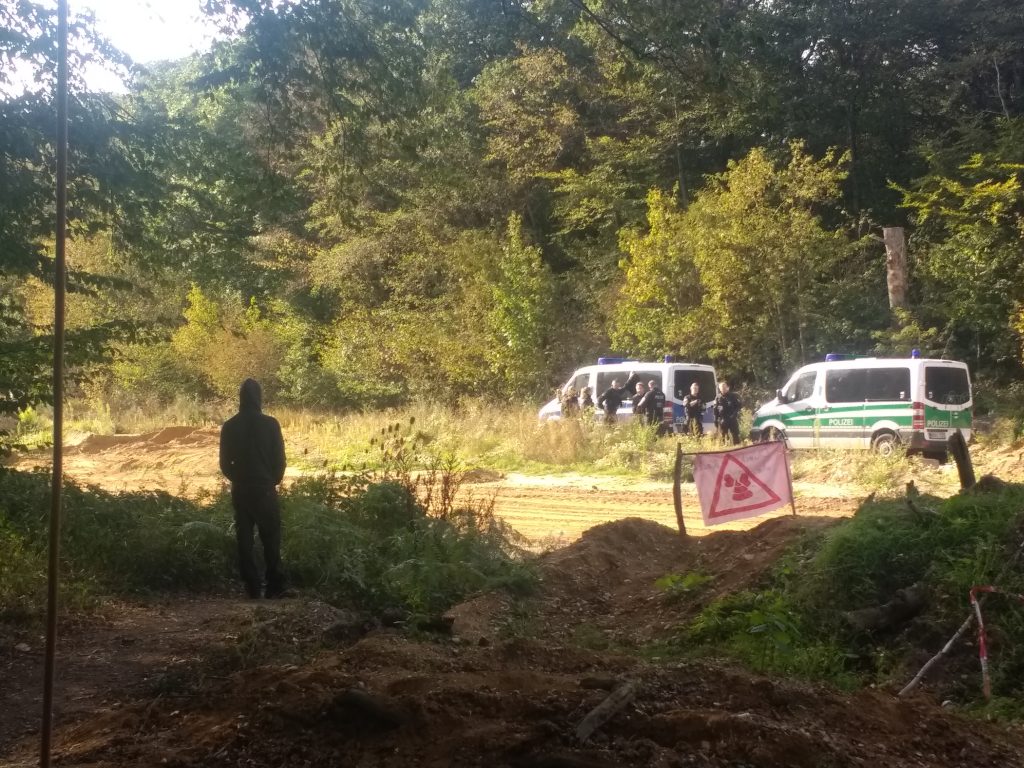
Over the years there have been many police actions, large and small, attempting to clear the forest of the occupiers. However police pressure on the occupiers is not constant. There are quiet periods and busy periods. During the autumn skill share week (a week in which people are invited to the forest to take part in a variety of workshops) the police presence was noticeable. There were many police vans driving around the perimeter of the forest and, at Krähen Nest, they would gather in large numbers at the edge of the forest multiple times a day. Krähen Nest is built right beside the old A4 Autobahn and the police and security guards could drive up and down this road at will (this road has since been blockaded by an extensive set of barricades). At various points during the day police would drive up, get out of the vans, stand at the edge of the forest and shout in. They would then be met by group of activists, and generally there was then an exchange of insults. But these exchanges would generally last less than 10 minutes, and the police never came into the forest. At night the police would shine their spotlights in at the camp.
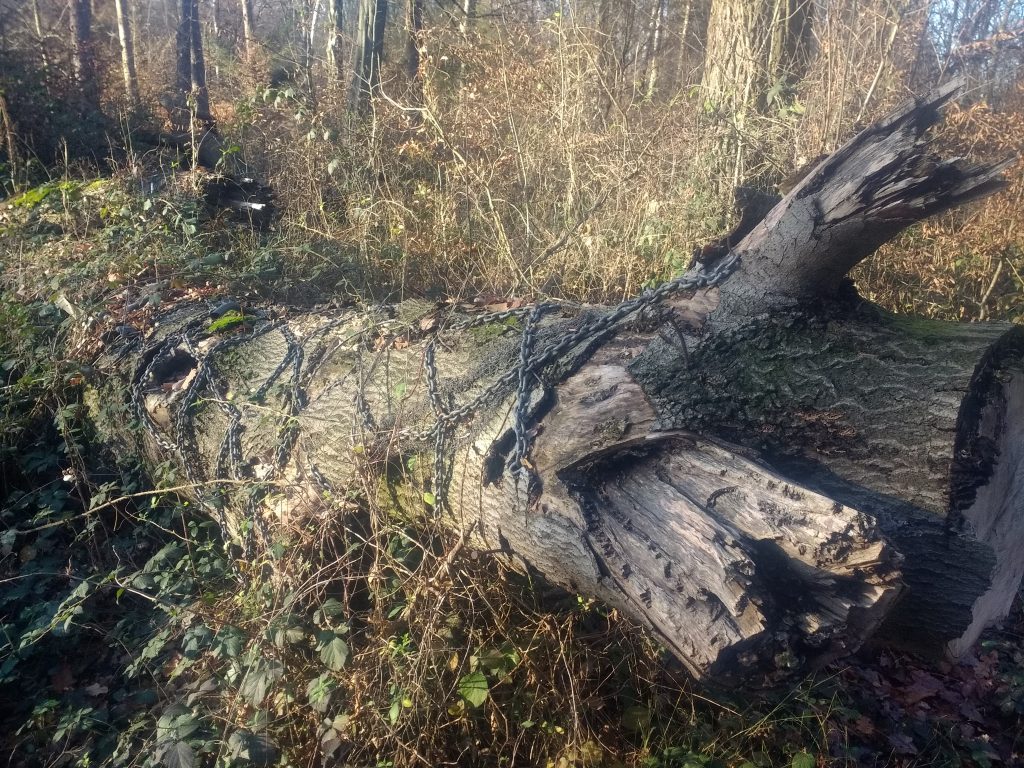
During my first climbing workshop a group of police began gathering at the edge of the forest. There was a couple of police vans and about 15 police, nothing so unusual, but anyway the person who was teaching me the ropes said, ‘ok, slowly come down, it’s better that we make sure nothing happens, we can continue later’. Suddenly a group of five more vans drive up the A4 and about 30 more police hop out and start making moves as if they were about to enter the forest. There was suddenly panic in the camp and everyone began gathering the materials and locking themselves behind the barricades. ‘Geh hoch! Geh hoch!’ (Go up!) my climbing instructor called to me as he began preparing for the incoming police action. ‘Shit,’ I thought to myself ‘my first time on the rope and I now have to flee the police. I haven’t even learned how to properly descend yet.’ Luckily the police were just putting on a little show, didn’t enter the forest, and I could continue with the climbing lesson. By winter, things were quiet in the forest and there was essentially no police presence.
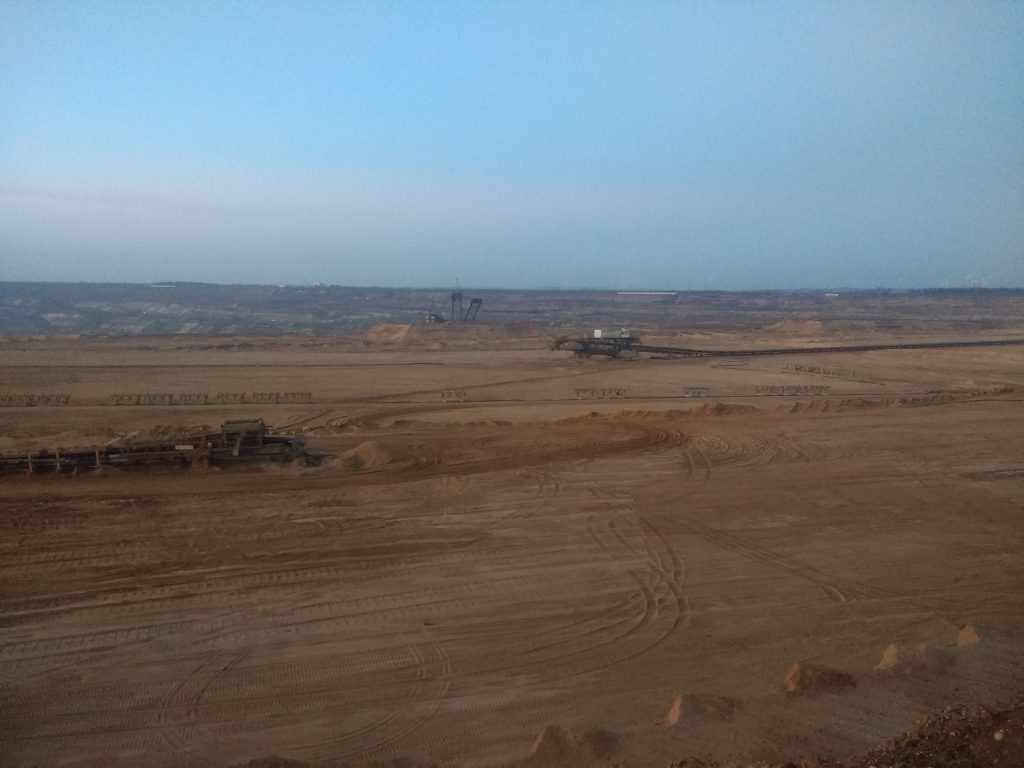
While I was not there for any large period of police actions, there were many people in the forest who were, and I can recount a few stories from the last large police actions. The was a huge eviction process that took place in September of 2018, which turned into the largest police operation in the history of the state of Nord Rhein Westphalen. Employing specially training climbing police, water cannons, cherry pickers, and Räumungspanzers (eviction tanks), along with a huge host of other measures, police spent weeks in the forest attempting to end the occupation once and for all. Occupiers didn’t make it easy for them, and had planned for just such an event. The treehouses were well supplied with all the essentials (food, water, toilet paper, medical supplies) so that occupiers could survives days, or even weeks, without needing supplies from the outside. And it ended up taking the police weeks. Aside from the variety of blockades, and technical complication of evicting the treehouses, activists announced Tag X (day X) had arrived, and sent a call out for people to come and support the forest. And the people came from near and far to protest the eviction and the continuing destructing of the forest. Young and old, punks and normal families, put on a huge variety of actions and protests, giving the police a lot to deal with on the ground. At the height of the demonstrations, in a protest that police declared illegal, 50,000 people came to show solidarity with the occupiers. But the police were determined, and using a variety of violent methods to subdue and arrest forest occupiers (with a journalist dying during these chaotic evictions, falling 20 metres from a walkway), they managed to destroy all the the settlements and treehouses (which numbered over 60) in the forest.
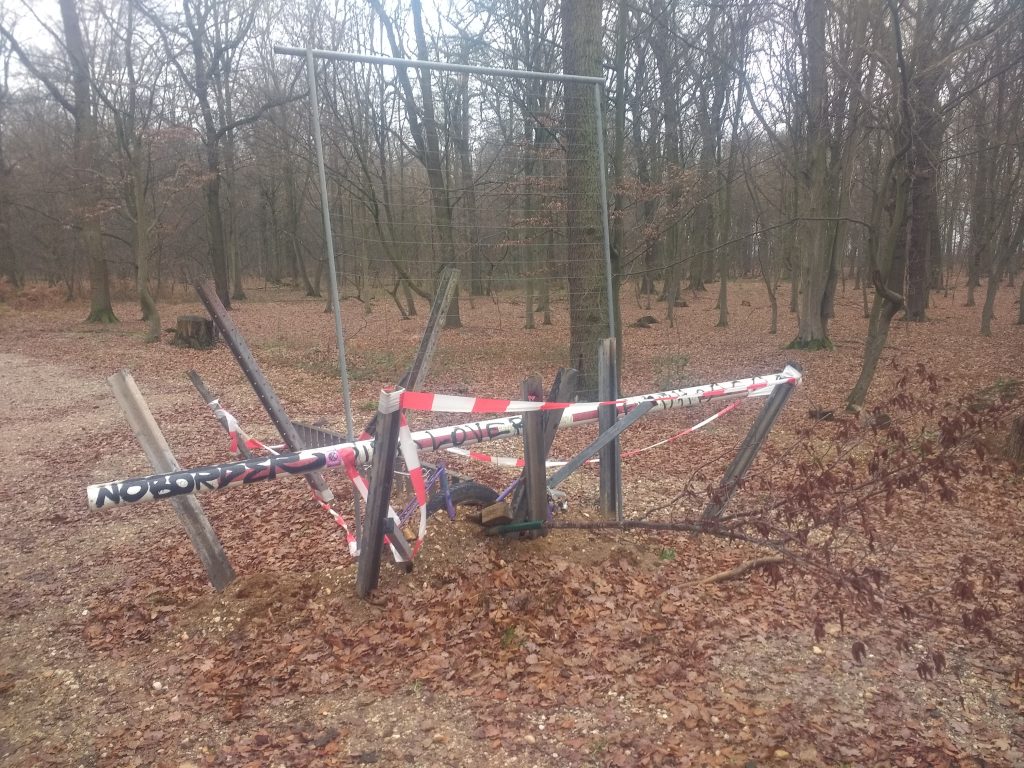
However, in a tremendous display of people power, even before the final evictions had taken place, activists were erecting new barricades and tree houses. In a huge collaborative action between various activists groups, many thousands of people streamed into the forest to assist with the rebuilding of settlements. This was no easy task. The first problem was how to get supplies into the area. Police had cordoned off a huge territory and everyone driving through on the road was subject to police checks. Anything that could be used in the construction of treehouses (tools, ropes, climbing belts, by the end even even sleeping bags) was seized. People had to think of other methods. One group managed to get supplies in through sheer force of numbers, hundreds of people breaking through a police line, with those in the centre of this crush having supplies. Others received help from locals. One person told me they were waiting in the nearby town of Mannheim when a local state bus passed by. The bus stopped beside them, and the driver told them hop in and hide under the seats. The police man, upon seeing the empty local bus, waved them through.
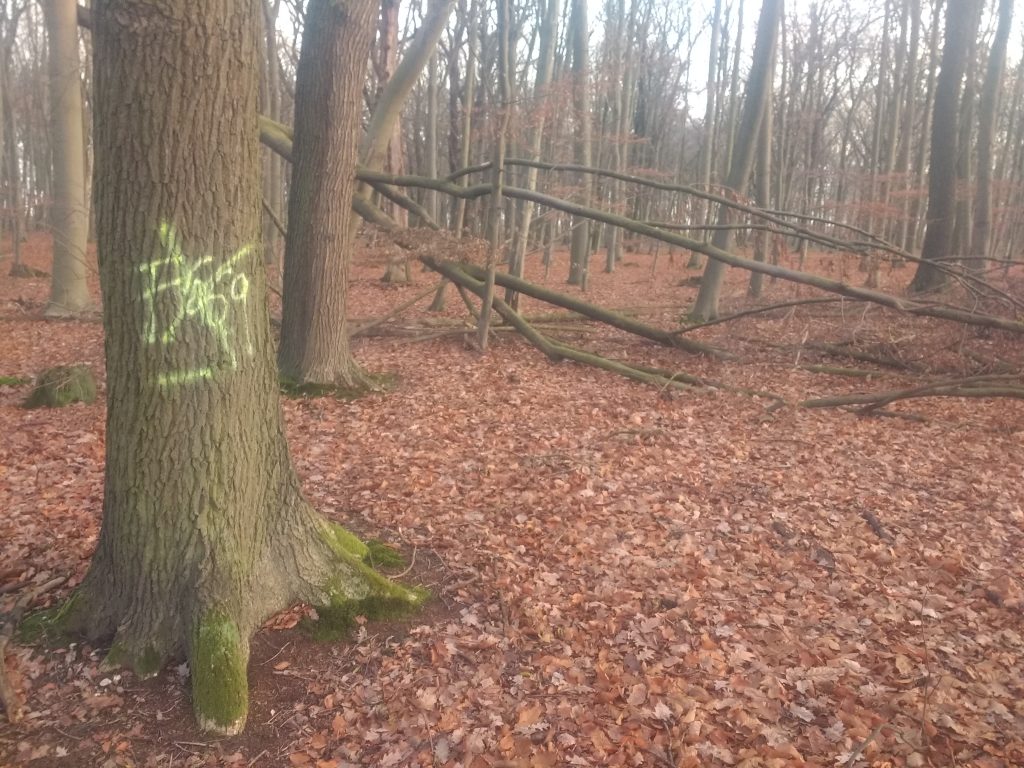
Materials in tow, the next job was getting the treehouses back up. Co-ordinated into many different fingers (like in actions at Ende Gelände and Free the Soil), these groups began strategical spreading around the forest. While some groups went back to rebuild old settlements, such as Oak town, others went into new parts of the forest. One group marched to the far eastern part, which had not previously been occupied, and began setting up barricades. Three trees were chosen as appropriate for tree houses and building began. Police attempted to break up the action, to disperse the finger and prevent the construction, but against over a thousand people, and with similar actions going on all over the forest, there was not much they could do. This huge number of people stayed over the weekend, giving the builders enough time to get the essentials done. On the third day of this action, when most people were beginning to leave, the foundations of this new barrio, Krähen Nest, were already lain (or rather the platforms were already erected). After this rebuilding action the forest occupation was even larger than before the evictions began in September, now occupying totally new parts of the forest. After the biggest police operation in the history of the state of Nord Rhein Westphalen, the forest occupation had only grown, and State forces realised their impotency against the force of the people. Dejected, they left the forest.

But the police haven’t given up entirely. They continue with their attempts to evict the occupiers so that the forest can be destroyed. Here is a translated first hand account of the siege of Krähen Nest that took place in March after an alleged shit throwing incident. [German original]
Ausflug
The moon is almost full,
as we stand at the vast precipice.
Five towers of cold steel,
digging their teeth into the earth.
Red lights blink in the distance,
and an eerie sound drifts through the air.
The cries of a suffering beast.
We decide we have seen enough,
and retire into the forest,
the crunch of shredded wood underfoot.
Autonomous Zones & Anarchist Communities
The forest occupation is not just about protecting the forest from destruction and the ending of the coal mining industry in the region. Another important effect of the occupation is the creation of an autonomous space based on anarchist principles. This creation of autonomous space is becoming ever more important in a world as more and more of the earth is colonised by State and capitalist forces. The privatisation of space in modern society means there is always less and less ‘free space’, spaces where you be without spending money. Spaces where you can simply exist. Aside from the aspect of privatisation, spaces (both social and spacial) built by modern society generally re-enforce oppressive normative ideals and promote consumer ideology. Autonomous spaces challenge the commodification of space, as well as offering a platform for challenging oppressive social and legal norms.
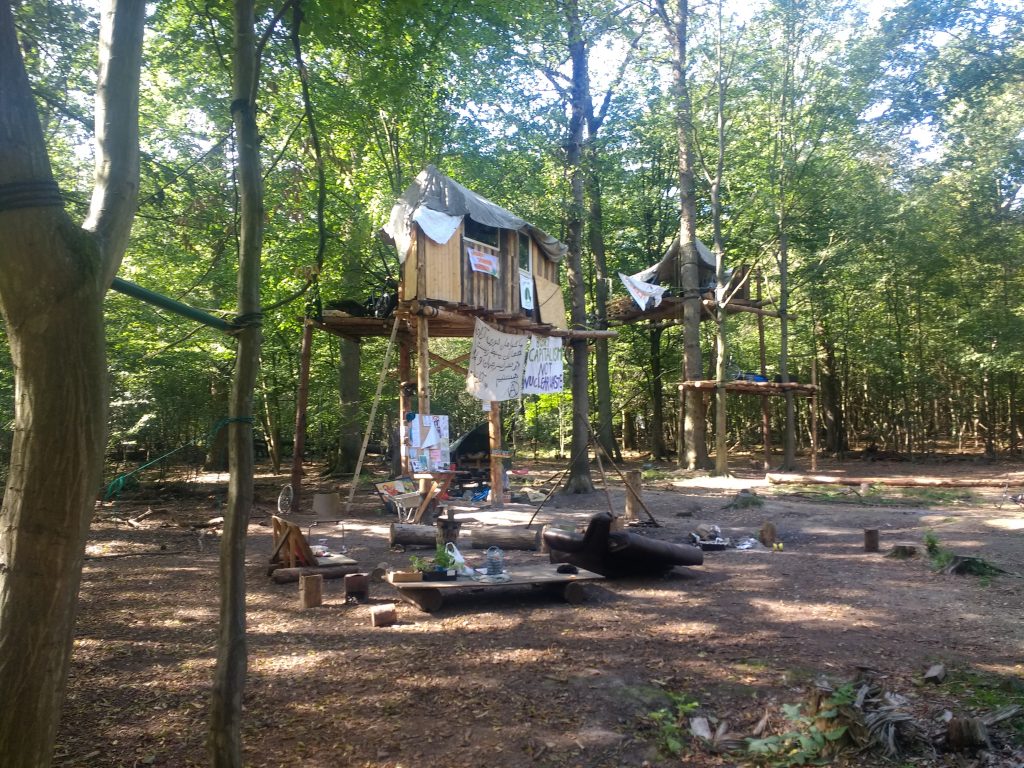
Autonomous anarchist zones can be found all over the world, from whole regions of cities that have turned into squats (Berlin or Athens), to settlements somewhere in the nature. However, as the State doesn’t tolerate any movements of local autonomy, these spaces are generally either destroyed or forced into the mainstream after a few years. There were a few anarchists spaces in Dublin over the past decade. The most impressive being Grange Gormen, which emerged in the fast gentrifying area of Smithfield. Once abuzz with working class communities, the redbrick residencies of Smithfield have become prime real estate in the city. Many houses and plots have been bought by up property speculators and the communities forced out. In one of these plots, a huge complex of houses, warehouses and parking lots, a band of anarchist punks built a community space where people could garden, gather for events, or hang out for free in a city where this is becoming less and less possible. However, this was not to be tolerated and the people of Grange Gormen were violently evicted from the space. This is in keeping with the agenda of Dublin City Council, and most city councils around the world – privatise and commercialise space.
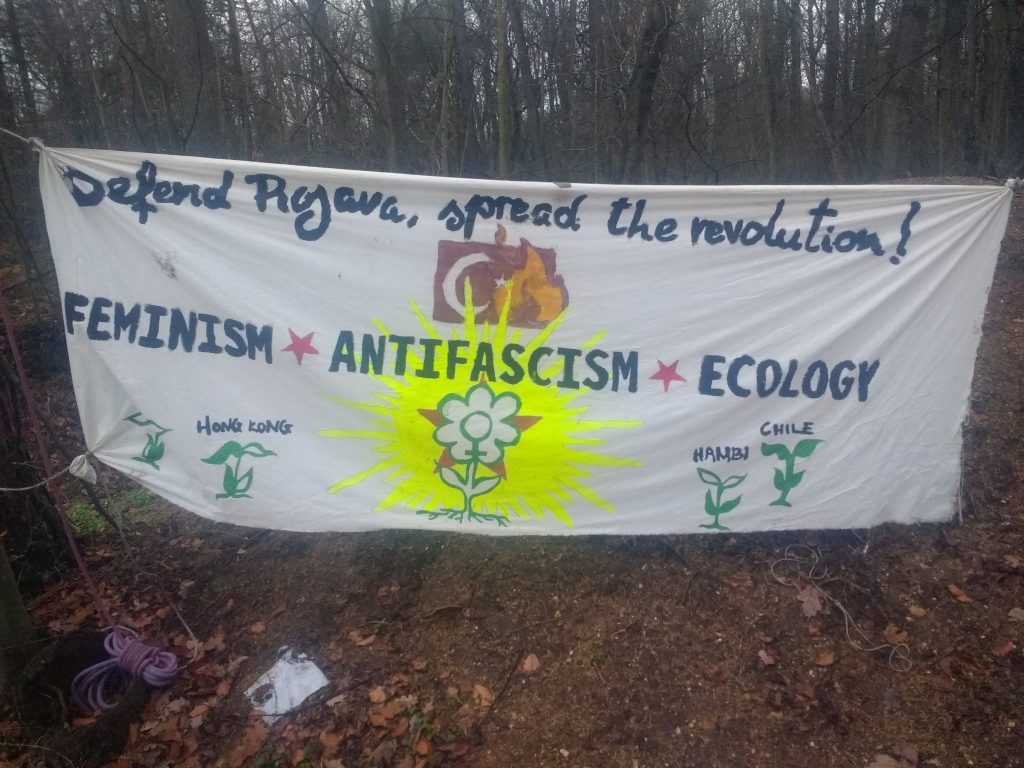
Hambacher Forst is another of these autonomous spaces, outside the remit of the law, consciously attempting to organise in an alternative way to mainstream society. With all the autonomous squats in Berlin being co-opted over the last couple of decades, it is the biggest autonomous space in Germany. This means that it is an important place for experimenting with the creation of anarchist communities. So Hambacher Forst functions as both a site of creation and a site of resistance, creating alternative communities on the front line of resistance. This has certain advantages over something like an eco-village in creating functioning alternatives to mainstream society. The main advantage is that it is a zone of legal autonomy, with the State unable to impose its jurisdiction. This prevents the State from enforcing unethical laws (such as private property laws that allows the destruction of a forest to extend a coal mine). A ‘legal’ community may become autonomous in every other respect, but acceptance of the legal authority of the State effectively consents to the rule of a centralised hegemony. Another advantage is the feeling of solidarity that comes with a collective struggle, of going through hard times together after something like an eviction or siege. This helps people to create community bonds.
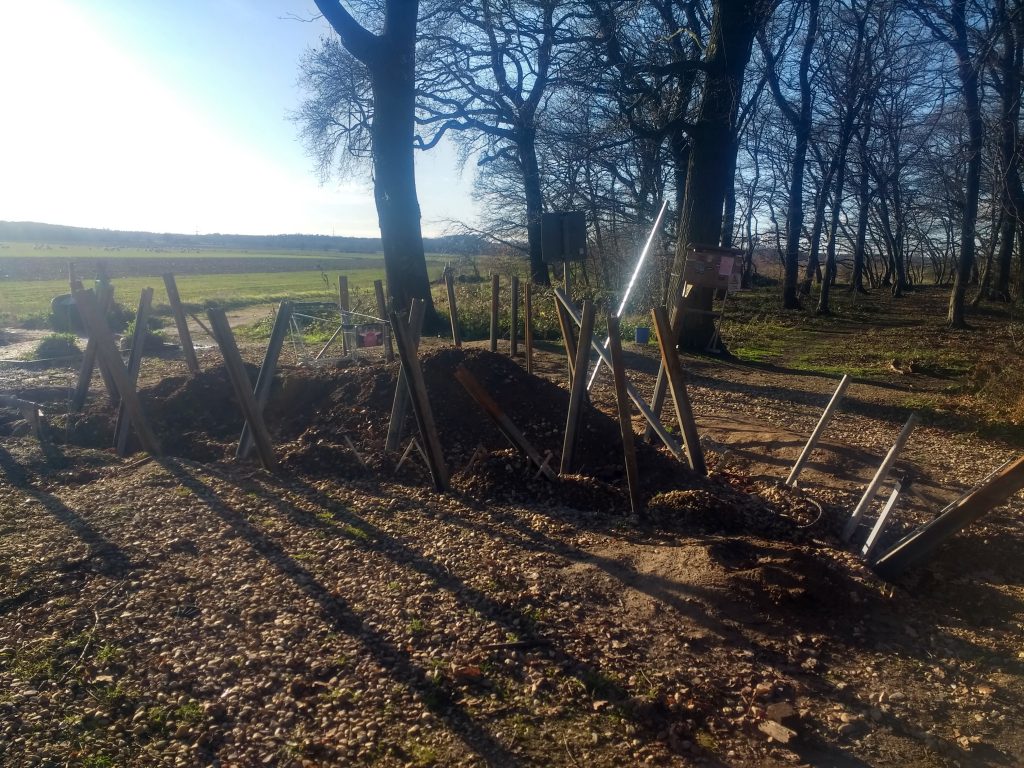
But creating a functioning community on the front line comes with a variety of difficulties. The most obvious being the uncertainty that comes with an illegal occupation. It is difficult to start a project (building a ground structure, a herb garden, etc.) when you know it will potentially be destroyed before it has a chance to come to fruition. This also applies to social structures. Co-operation, exchange, and regular gatherings do happen in the forest, but a big eviction means these social institution are disrupted, and have to be built up again. Adding to the transient nature of these communities is the fact that most people only stay in the forest for a short time, a few months or maybe a year or two. I don’t think there is anyone left in the forest from the original occupiers seven years ago.
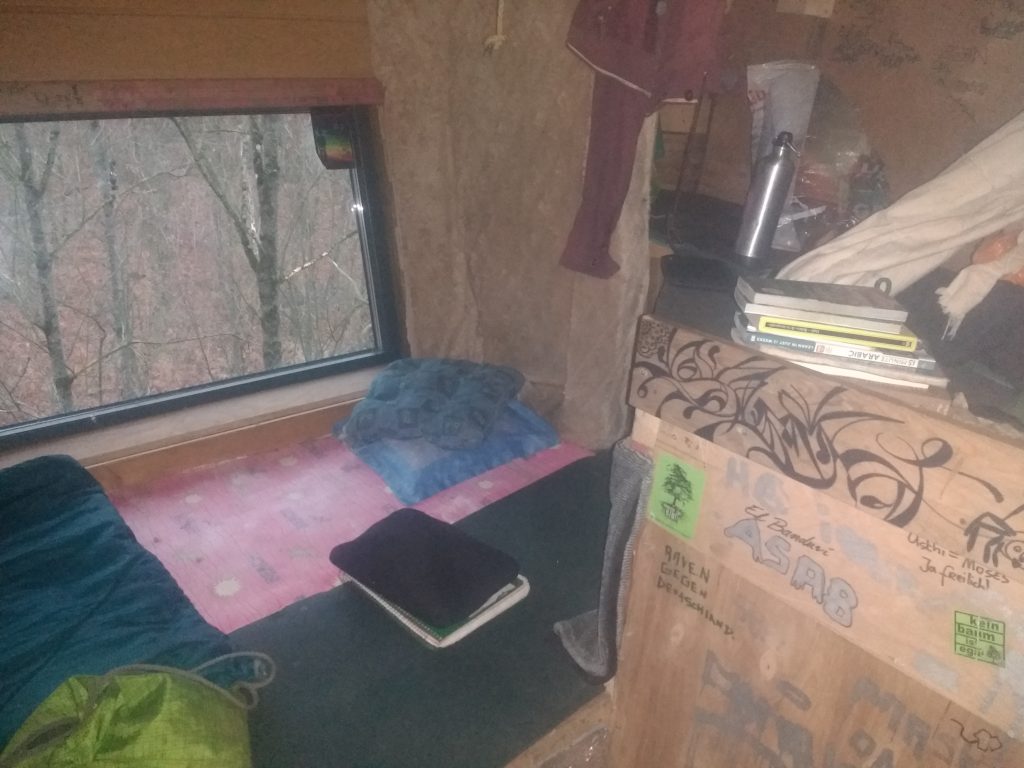
Another difficulty in the creation of communities is stress. The constant threat of police eviction has an effect on people. The general stress of the situation sometimes leads to poor communication and general apathy from forest occupiers. To go with the stress of the forest, autonomous spaces generally attract people who don’t fit into mainstream society, and these people sometimes come with their own mental health problems. Despite this being an obvious issue in the forest, there is little support structures for people with mental health problems.
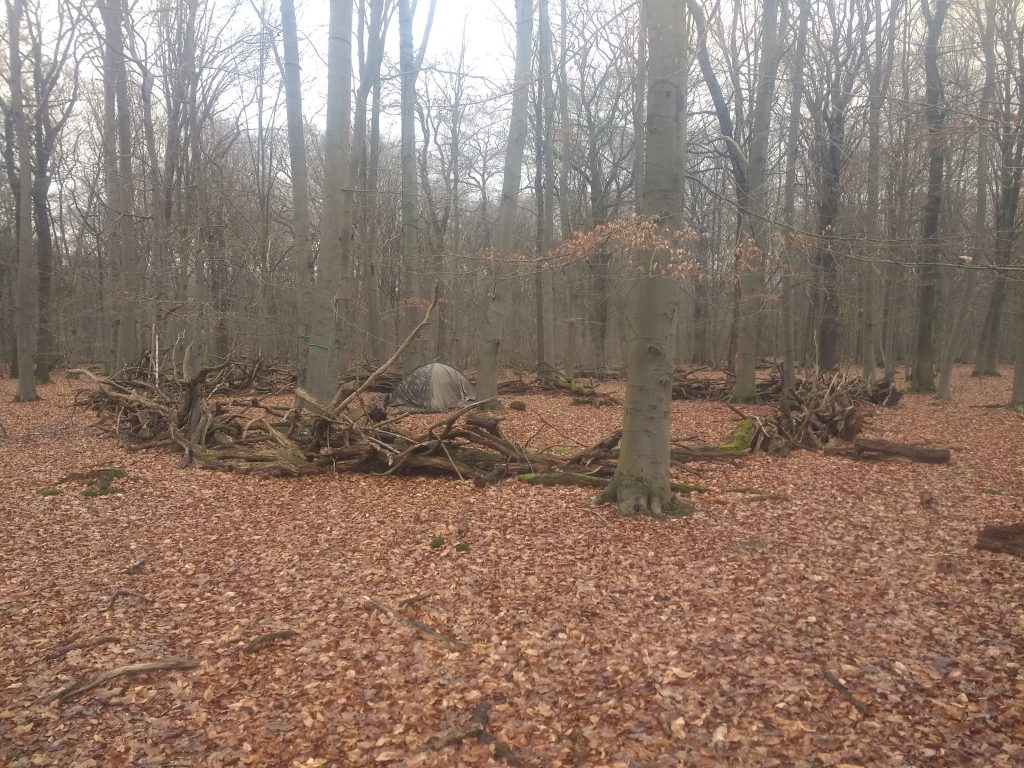
Communications between barrios is also not also totally up to scratch, and a lot of people spend most of their time in a single barrio. A final difficulty in the creation of anarchist communities in the forest is that people are there for a variety of reasons; some are activists who want to transform society, some need a place of refuge from mainstream society, some just want a place where they can come live in a tree house and take drugs. This is a point we will return to in a moment, but right now it’s enough to say that building meaningful communities under these circumstances is no easy task. But it is happening. People are coming together to try and create a new type of relationship with other. Relationships based on different values that the hierarchical, competitive, individualistic values found in capitalist society.
Anarchism in Practice
These values are based on the philosophy of anarchism. However, what exactly anarchism means in practice is open to interpretation. In broad terms, we can say it means organising life in a non-authoritarian, non-hierarchical, and non-exploitative manner. To begin a process like this requires reflection upon ones own behaviour, and sometimes challenging the behaviour of others. For example, if people in the barrio begin regularly taking food from a communal space to their private tree-house, appropriating the communal resources for themselves, this could be considered capitalist logic that can be challenged. Or if some people in the barrio do all the work, or all of one type of work (cleaning and cooking for example), then this is also something that can be challenged, as it is often an expression of unspoken hierarchy, and the reproduction of hierarchies which exist in mainstream society.
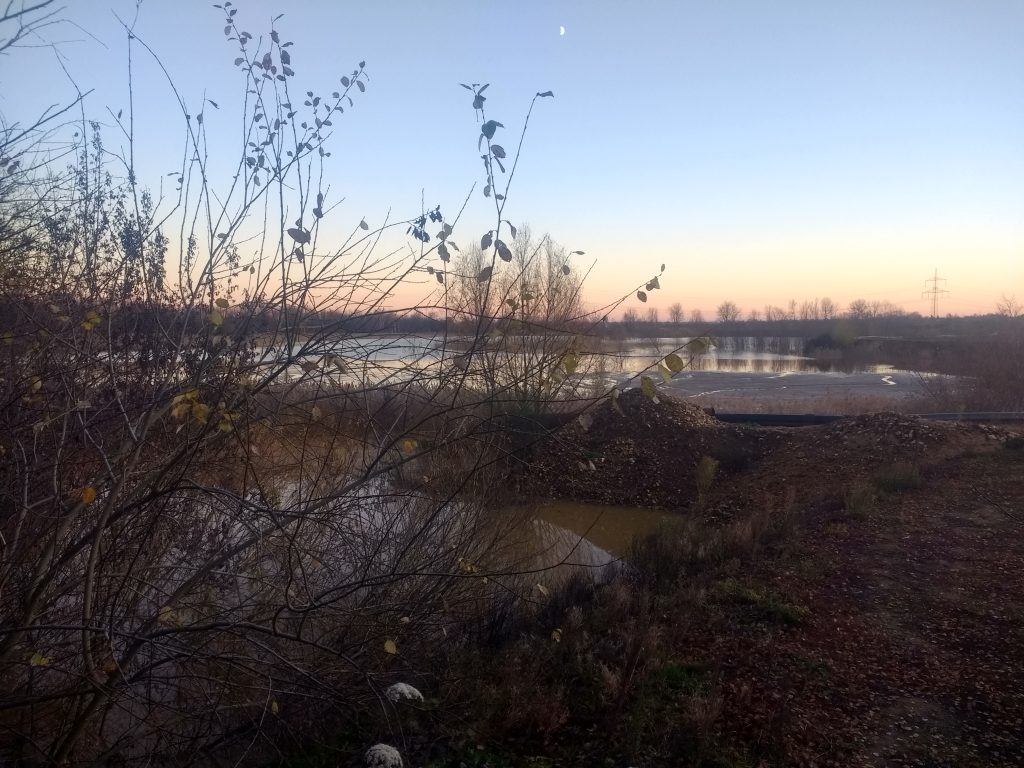
It will perhaps come as little surprise that the most common hierarchies that is reproduced in the forest is generally that most deeply rooted of hierarchies, the hierarchy of men over women. While the forest is certainly a much better place for women than many areas of mainstream society, old unconscious gender roles tend to reproduce themselves. Men tend to do one type of work, and women another. Some voices are heard and respected more than others, and those voices are often male voices. These hang ups from a patriarchal society are regularly challenged, both on the day to day level of conversation, and through larger actions. Each barrio has a 30 page booklet on feminism in the context of anarchist spaces, and there was a workshop held on toxic masculinity held in Krähen Nest. But there is no magic bullet for overcoming the patriarchal ideals we have been socialised with. To create a more egalitarian co-existence, to alter such deep rooted values and practices, is an ongoing process that requires constant reflection.
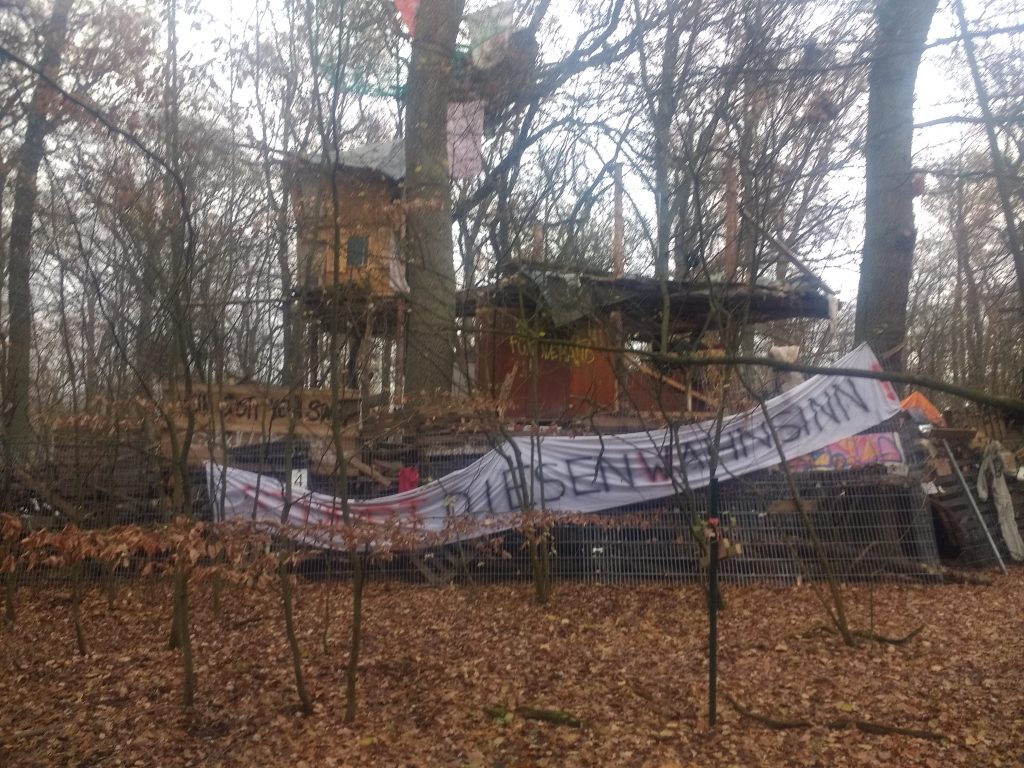
While the forest strives to create a space free of hierarchy, a hierarchy of values is impossible to avoid. In the act of establishing what is good, you establish what is bad. In defining what is right, you define what is wrong. As I said before, the concept of anarchy is something which is constantly up for debate. For some anarchists, such as Leo Tolstoy or Mohandas Gandhi, anarchism means the absence of violent coercion. They argued that creating a world free of unjust hierarchy and creating a world free of violence are essentially equatable in terms. To create a world without violent coercion, we must start with ourselves. This was not the general opinion in the forest. As in many of the autonomous anarchism spaces, anarchist ideals are fused with elements from the destructive impulses of the punk cultural and a kind of militarism that naturally arises in in places that find themselves under regular attack. Added to that is the influence of the Antifa on the German anarchist scene. The Antifa (short for anti-fascist) are leftists whose main aim is the prevention of the rise of fascism again in Europe. To this end the Antifa sometimes use methods of violent repression of known nazis, and a lot of the antifa imagery and symbolism is pretty violent. Common graffiti in forest are things like ‘Kill cops’, ‘Eat Hippies’, or ‘No to Pacifism’.

Although organised around a non-violent action (the occupation of the forest), the hegemonic understanding in the forest is against philosophies of non-violence. The reasons for this are varied. For some people, it is that the State uses violent action, so activists should be able to combat that with violent action of their own. For others, it was a matter of self defense, when one is under attack, one has to defend oneself. This was a topic during the discussion on toxic masculinity that was held in Krähen Nest. One person said they felt the entire culture of militancy and symbolism of violence in the forest was an expression of toxic masculinity. Another person replied that they thought militancy has some positive potential, that women need to be able to defend themselves physically against structural violence. While the topic of violence is something that is too big to address in this text, it is an important one, and at the heart of the divide in contemporary anarchism.
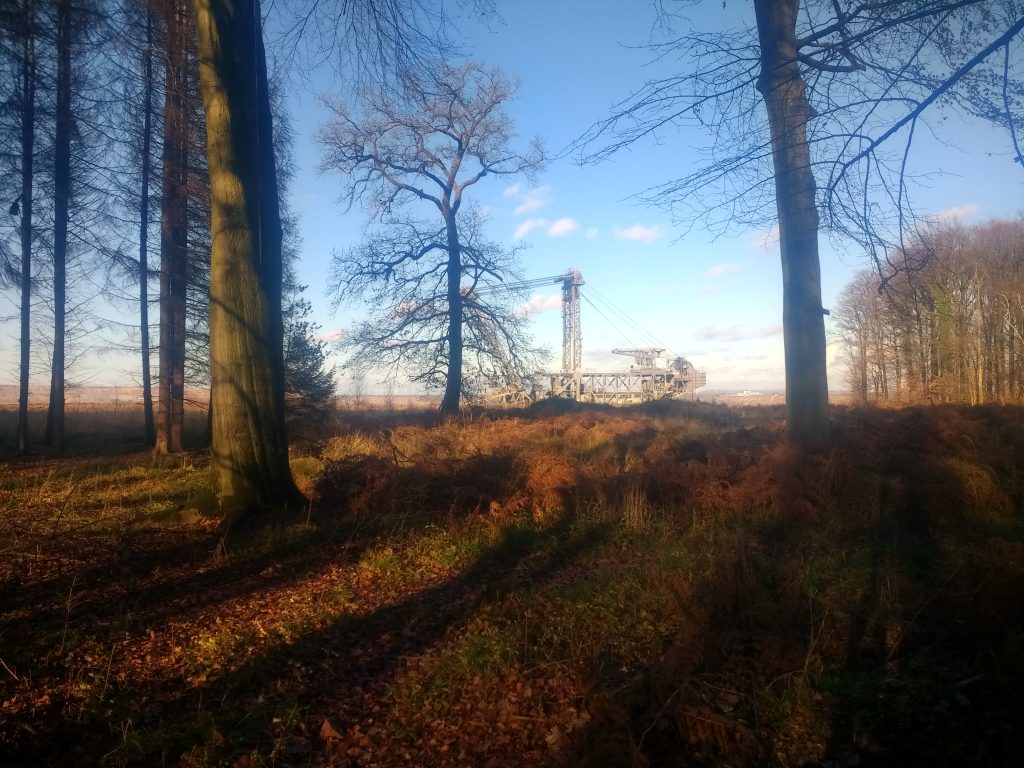
Another important debate revolves around the idea of ‘freedom’. For some in the forest freedom means the ability to do whatever they want, that nobody can tell anyone else what they must, or even should, do. There are people who come to forest, live in the community, but don’t contribute much to it’s functioning. They see the forest as a nice place to live for free, chill, and take drugs. Because the anarchist ideals of allowing individual freedom means that it is possible to live like this in the forest, at least for a while. But this is an understanding of freedom more akin to bourgeois individualism than anarchy. It is the freedom to live on the backs of others; the freedom to exploit (a freedom held so dear by capitalist society). Real freedom comes with responsibility. The freedom to live fruitfully in the forest comes with the responsibility of cleaning, cooking, maintenance, supplying food, etc. If no-one takes on these responsibilities, there is not the freedom to live in the forest. If some take on these responsibilities and not others, subtle hierarchies begin to form and crystallise. This is one of the main points of contention in anarchist communities; how to maintain egalitarian relations while preserving individual freedom.

Relation to the Outside World
Despite sometimes violent symbolism in the camps, and the promotion of violent methods in discourse, forest occupiers are peaceful, generally friendly, people. People who come visit the forest with good intentions can expect a warm reception in most camps. If you want to come here to live, you will find a place. The forest is happy for people who want to commit themselves to the struggle. The forest is also a place that many people visit for a short time, and there are often non-forest occupiers of all backgrounds who come to hang out for the day and see what happening. Much of the food in the forest come from ‘supporties’, people who support the occupation and donate food and supplies. Shows of solidarity from the local people are not only essential for keeping the forest supplied, but also keeping the spirits in the forest up.
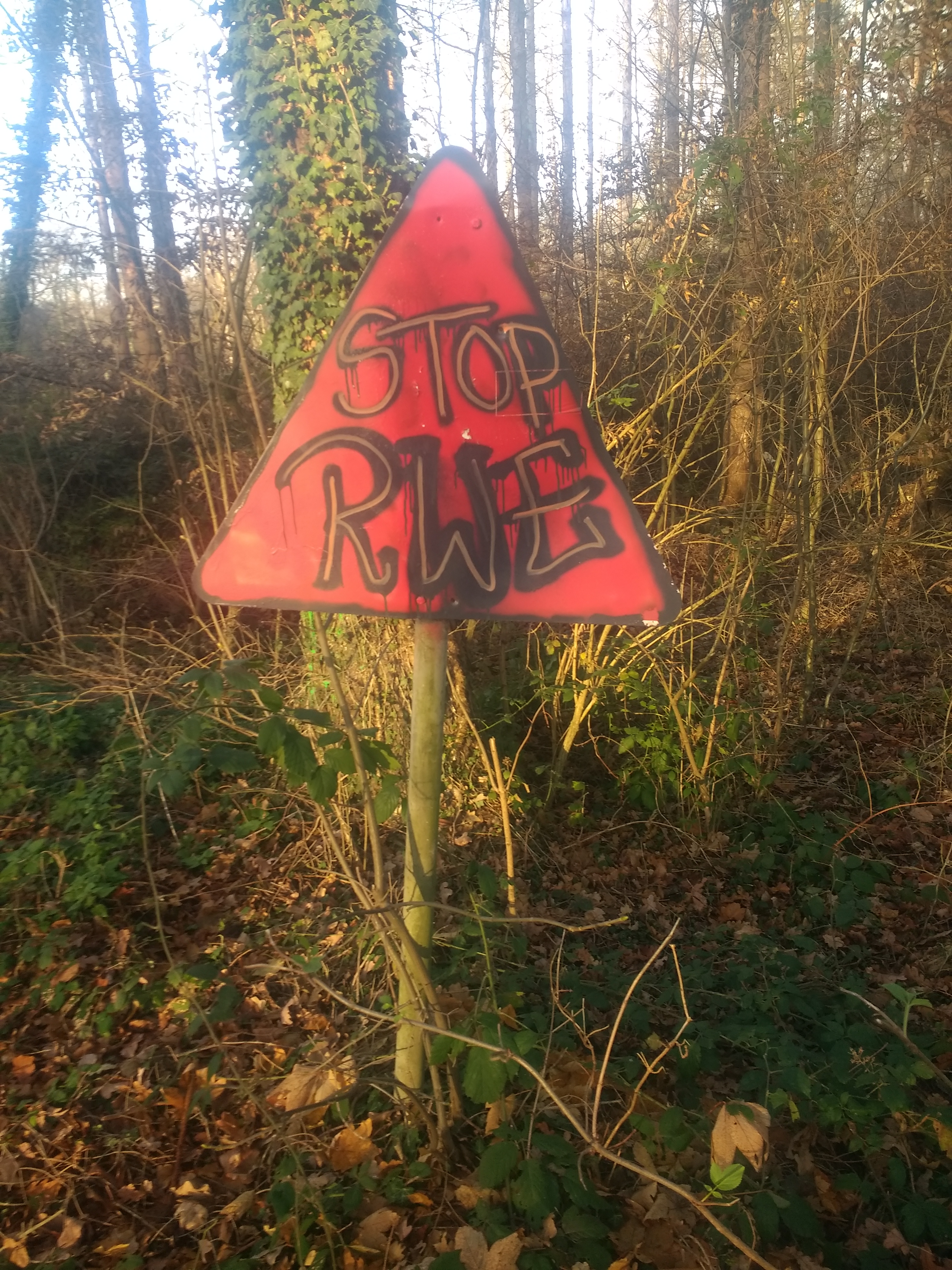
One morning I came into the Mannwache to find an old man cleaning and doing the dishes. He gets an early train twice a week from Cologne, cleans up, and then heads home, sometimes without seeing a soul. A short time later a very nice elderly woman came in, fuming that nobody had answered as she rang the Mannwache mobile phone. She had spent the whole morning cooking soup and was not leaving till people of every barrio came out to get some. She ordered me into the forest to send the word. After a bit of tasty soup, I duly obliged. I later found out that she hosts Christmas celebrations (cooking food, mulled wine, etc.) for the forest occupiers at her house, close to the forest. These are just two examples, but each day was filled with numerous acts of generosity, warming the heart, and proving a much needed contrast to the selfish destruction happening on the far side of the forest.
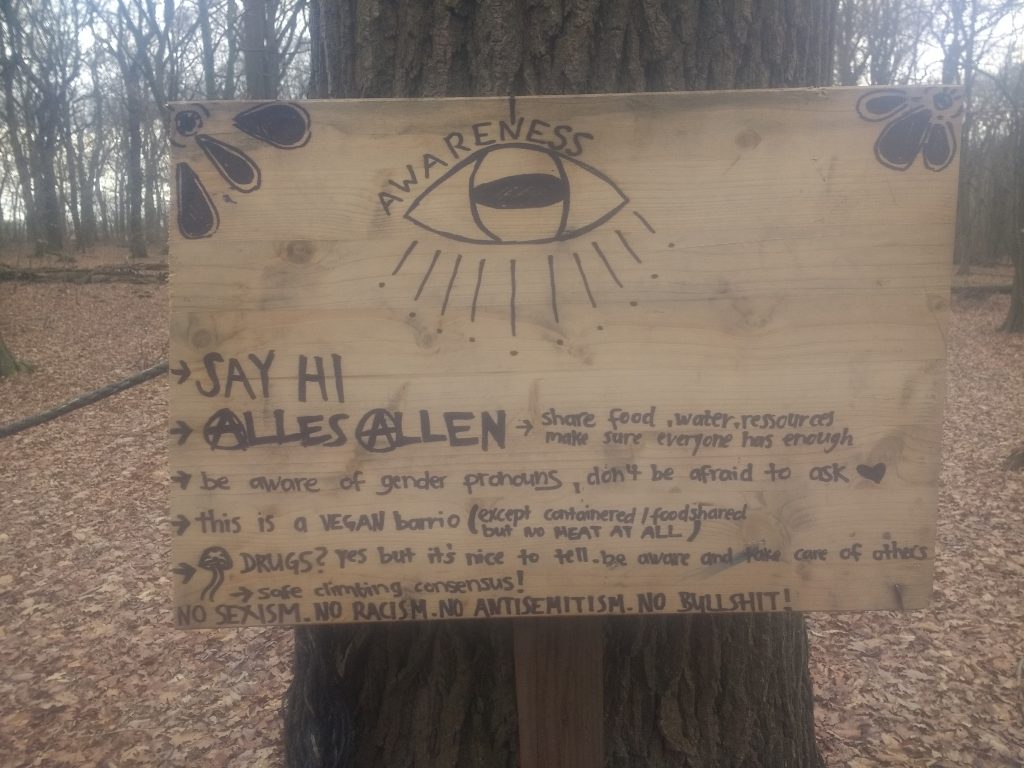
Life in the forest is simple.
I sit and tend to the fire.
As company tonight I have the crescent moon,
and the far away hum of heavy machinery.
A low whistle tells me the water is ready,
I throw some leaves in a cup and drink,
following the warmth the whole way to my belly.
Nothing else to do,
I watch the fire go out,
and go to sleep.
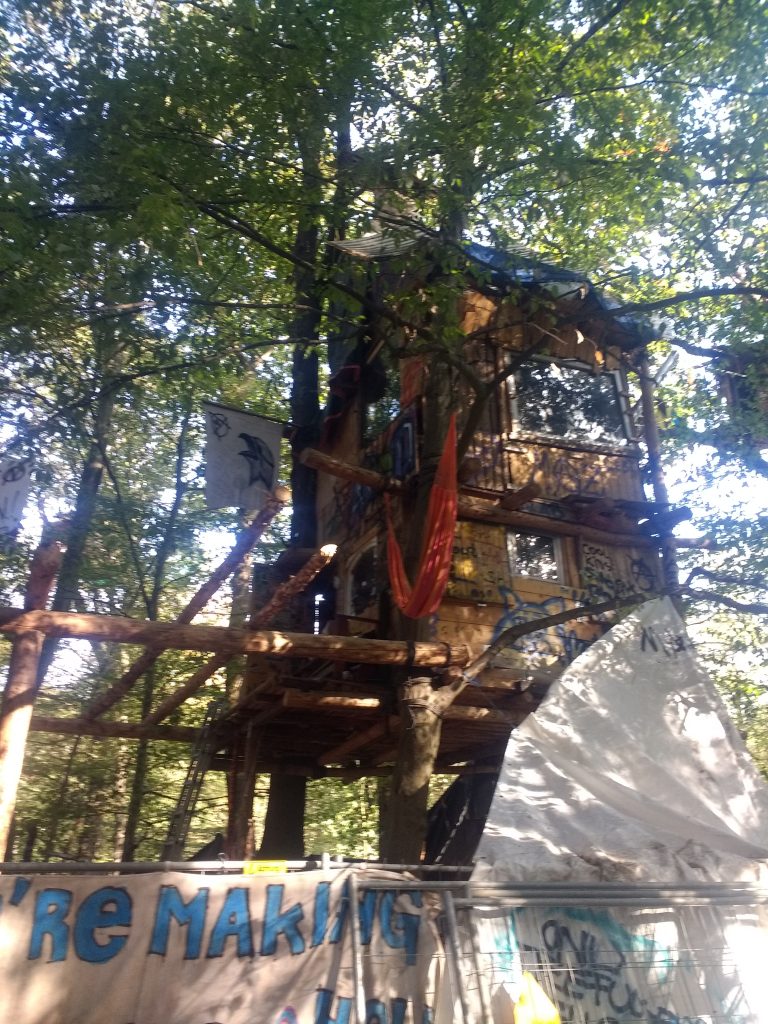
Although the struggle in Hambacher Forst is centred around a local issue, preventing the RWE from destroying the forest, and the establish of an autonomous space, many forest occupiers also keep a wider view of what was happening in the world. On the first Sunday of every month there is a Waldspaziergang (forest walk about), where people from the local area and civil society groups are invited to the forest to see what’s happening. This event is a chance for the forest dwellers to engage with the outside world and locate themselves in the wider constellation of global struggle. One Sunday was in solidarity with autonomous Kurdish region of Rojava, recently invaded by Turkey, with speakers talking about the current situation in the region.
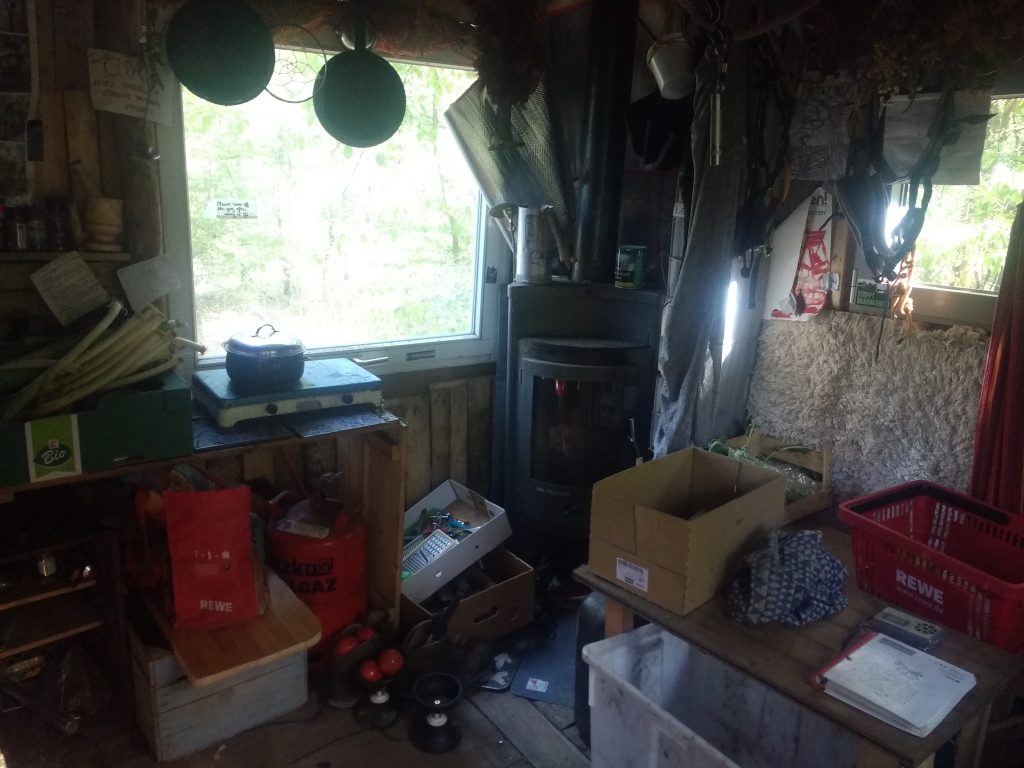
On Friday evenings, there is a discussion group under the heading ‘Let’s talk about revolution’. Here the space is open to talk about other struggles happening around the world, and how we in Hambi could potentially learn from, or support, them. We talked about the movement in Chile, its feminist aspects, and then the feminist movement around the world. We talked about the ingenuity of the protestors in Hong Kong, who fashioned catapults from what they found on the street. We talked about the government crackdown on the anarchist spaces that was underway in Greece. We discussed ZAD, an occupation of a piece of land in France that was going to be turned into an airport. This occupation turned into one of the largest autonomous spaces in Europe, and began causing headaches for the French Nation State, compelled to impose its sovereignty on every square inch of its territory. In the end, the airport was cancelled in the hope that the autonomous space that formed against it would disbanded, which, after a period of conflict and division, it did. The question was then put; ‘what would happen to the autonomous space of the Hambacher Forst if the objective of preventing the expansion on the mine is successful?’
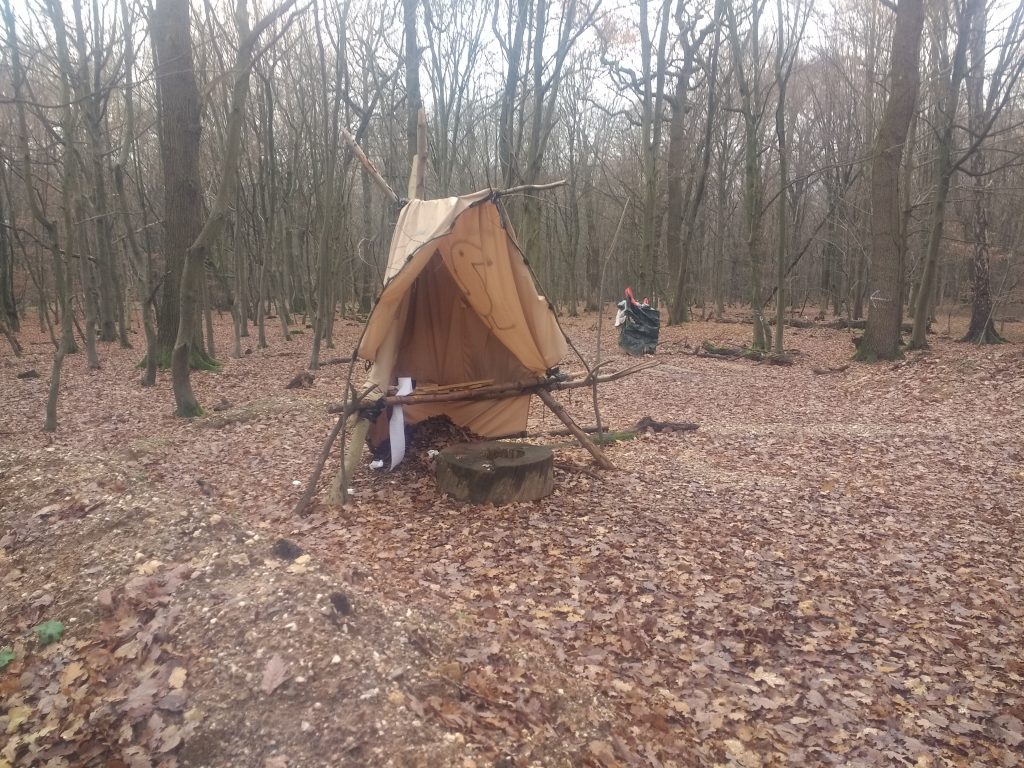
Day to Day
Most mornings I would be the first one awake (or at least the first one moving about) in the camp. A creature of habit, I usually start the day with a coffee. For that I need fire, so I first head to patch of spruce monoculture beside our camp. Like most monocultures, these spruce were ravaged by pests, and all died. These dead spruce trees are the main source for firewood and building supplies at the camp. For a small morning fire the small branches on these dry corpses are sufficient. The snap reverberates through the morning stillness. Sticks and twigs in arm, I head to the fire pit. Here I am greeted by a few songbirds (great tits) who come to eat breakfast with me. I get the fire going, throw a metal grate on top of it, then put the percolator and a few pieces of bread on that. After enjoying my buttered toast and coffee, I read a little bit. Eventually others wake up and join me, rekindling the glowing embers for another round of coffee. The whole process was slow, time consuming, but relaxed. In harmony with a forest that was also slowly waking up.
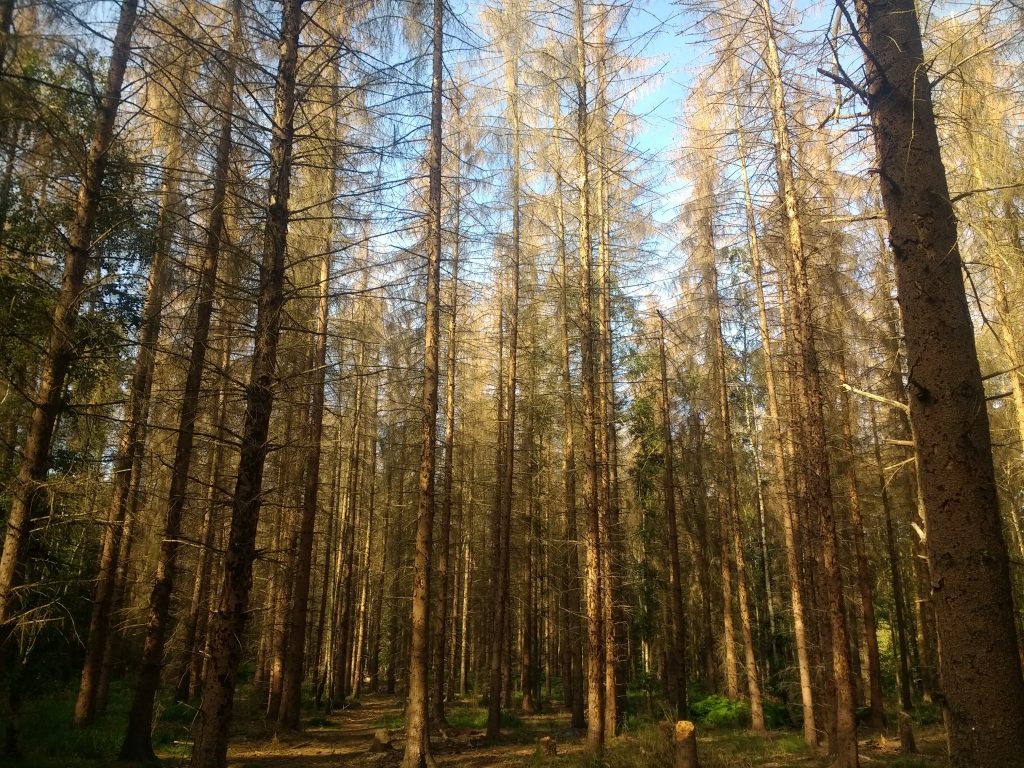
And this is typical for life in the forest. The pace of life is slowed down. The things that you normal do quickly before going to work become occupations. All the things that one normally takes for granted (warmth, food, hygiene) once again become something that you have to work for. If you want to cook, you must create fire. If you want to keep warm in the winter you have to build shelter, then make sure that this shelter protects you from the elements. If you want to keep animals out of your food, you have to build storage. Some people may think it is a luxury not to have to work for any of these things any more, but in my experience, working for what is essential is fulfilling. Instead of working to make someone else rich, to sell something, you work to provide yourself and the community with the greatest treasures in this world. What greater reward could there be for a few minutes work collecting wood than fire? What could be more important after a few weeks building a tree house than protection from the wind and rain? What is it that we value so much in our modern lifestyles? What it is that is worth the untold degradation and destruction? In the forest it appears that many of the comforts and luxuries that we have come to expect only distract us from the essential.
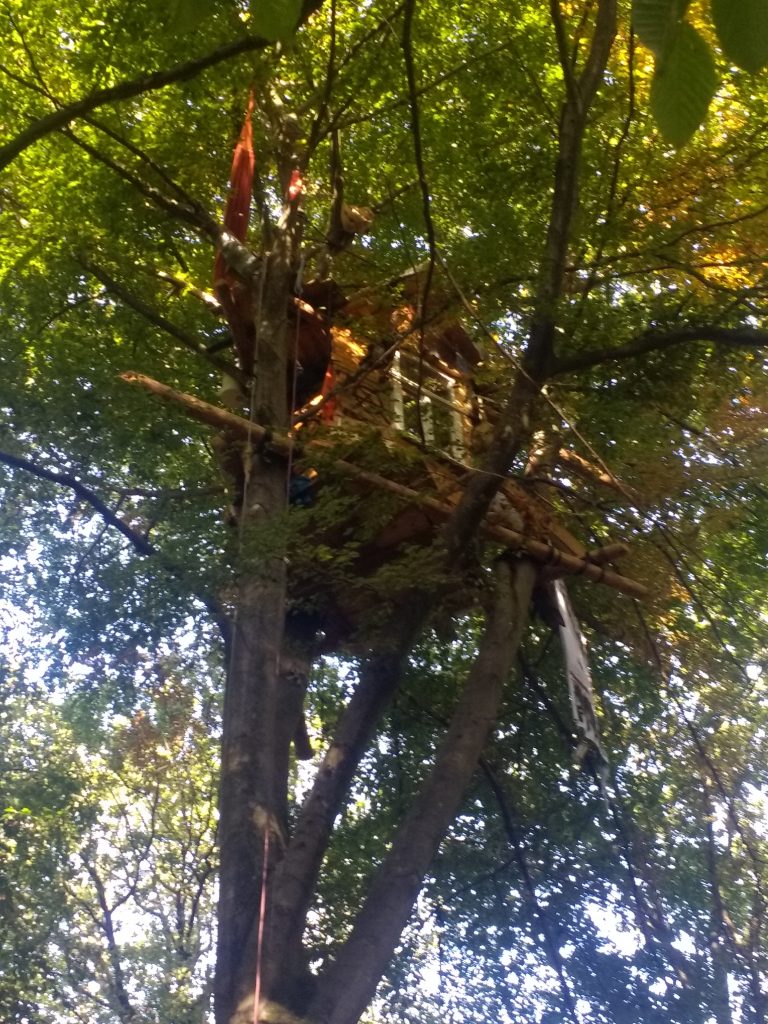
How is it that we have made so many machines to ‘save’ time, and yet modern people have less time to spare than ever? We spend our lives running from one place to another, without really thinking about where we are going. In the forest we may not have all of the luxuries we have gotten used too, but in return you get two of the greatest luxuries of all; time and stillness. With time, you are able to decide yourself what you would like to do with the day. With stillness you flow with the natural course of events. There are certain tasks that should be done. If no one collects wood, there is no fire. If no one cleans the camp, rotting food attracts animals. But the only enforcer of these actions is your own volition, the only motive is your own needs and wants (or those of the community). And once these basics are covered you are left with infinite possibilities. Maybe you want to work on that balcony that will give the community a new place to chill. Maybe you want to better insulate the tree house so you don’t need to use three blankets in winter. Maybe you want to build a clay oven to make pizza. Maybe you want to get to know some of the edibles herbs and mushrooms growing in the forest. Maybe you want to organise a discussion group on anarchist literature. Or maybe you don’t want to do any of that, and would rather chill by the fire all day. The day is yours, your time is not dictated or regimented by anyone else. As opposed to the alienating labour doled out by industrial society, the work done in the forest is self-realising; you come up with a project suited to your own needs, desires, and interests, plan that project and see it through.
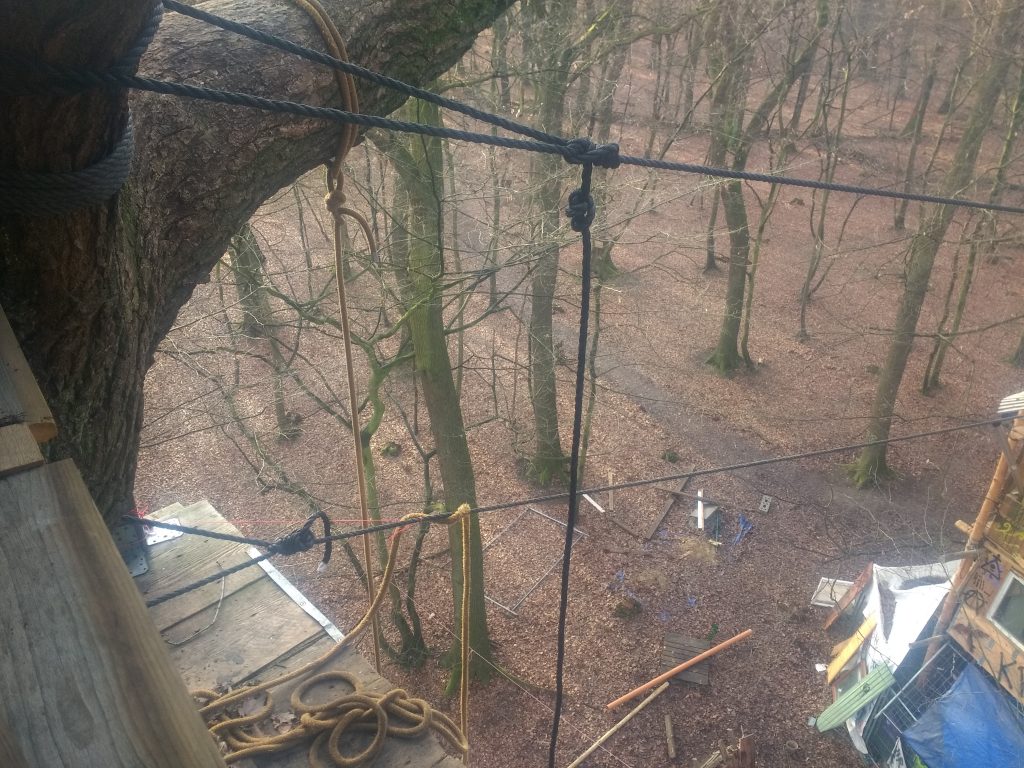
The final thing to mention about the day to day life is the joy of climbing. As well as being a useful defensive strategy, climbing high above the trees is lots of fun and adds another dimension to life in the forest. As well as living in tree houses built upon sturdy oaks and beech trees, there are platforms, walkways and nets suspended high in the air to hang out in. Climbing is a skill that many have learned in the forest for the first time, and are happy to pass on the favour. There are enough spare belts, carabiners and prusiks to spare for those without equipment. The basics, how to go up and down the rope, how to get across walkways, are simple enough. Its a matter of learning a few knots, a few techniques, and trusting in the rope and the branch you are hanging from. With these basic skills you can live like the birds, high in the trees, observing the forest below. The longer you stay in the forest the more you can learn; how to rescue other who are caught in the rope, how to scale trees without a rope, how to secure support beams to trees to build tree house.
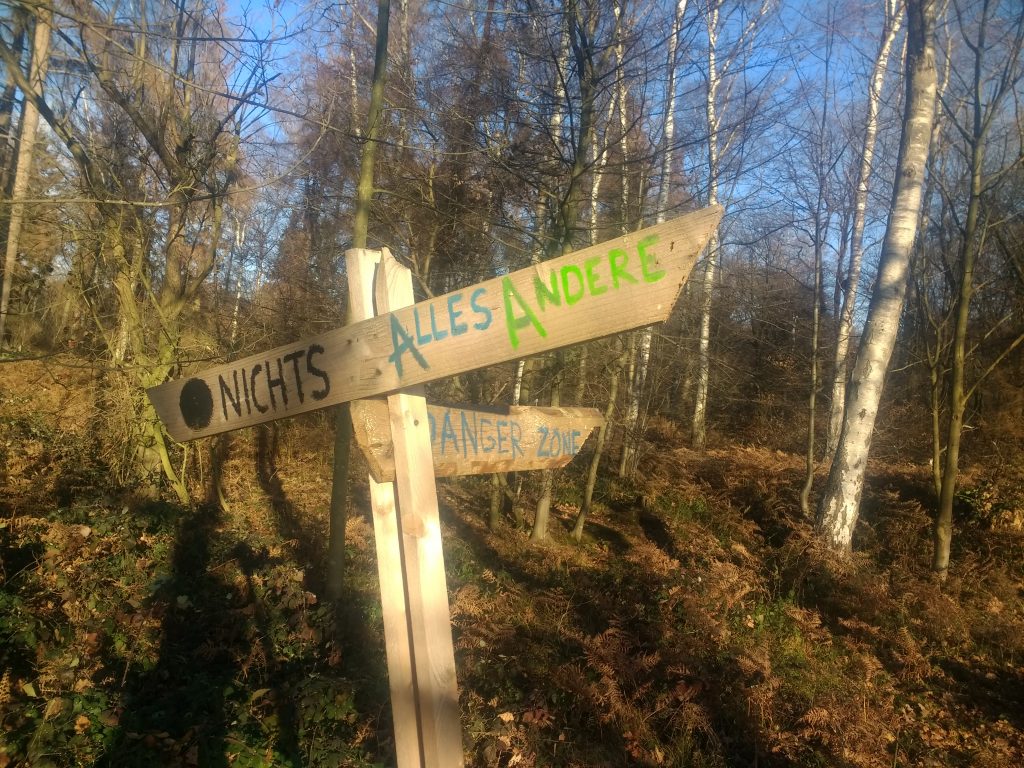
Fin
The final important thing to mention about the Hambacher Forst is the amount of people that come here to see that such an action is possible, and then learn the skills so that they can do it themselves. In my first week in the forest there was a skill share event. A Czech person was there to give a workshop on industrial blockades. It opened a discussion on the various environmental actions happening around Europe and where they needed support. We swapped information about other potential targets for direct actions. We talked about various strategies of disruption (different types of lock-ons), as well as the legal consequences for undertaking such actions.
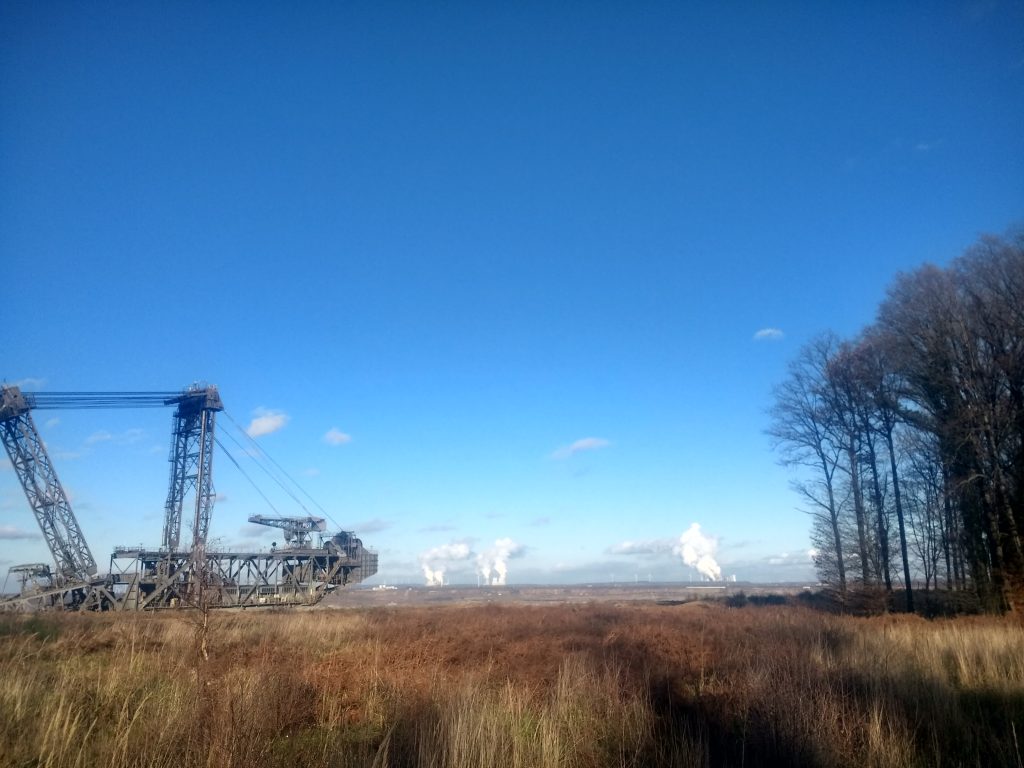
A few weeks later, a group of Belgian people arrived at Krähen Nest asking could they look around. They had recently begun their own forest occupation in Belgium, but were yet to build any treehouses. They came to Hambacher Forst to see what was possible, and take inspiration in what had already been achieved. They left emboldened to take their action to the next level. I only found out after that activists from Hambi had visited this occupation a few weeks previously to teach them how to climb. A few weeks before that, people of the forest had done the same thing at new occupation in Germany in the Dannenröder Wald. Here activists are aiming to prevent the forest from being turned into a new autobahn.
The value of the Hambacher Forst occupation is multifaceted. First you have its main function, saving the forest from being destroyed. Next is all the pressure it brings to bear on the whole coal industry in Germany. Then you have the value of its existence as an autonomous space outside the jurisdiction of State and capitalist forces, as well as being a platform to experiment in creating anarchist communities. As well as this, it acts as a centre for skill sharing and information exchange on environmental activism. Finally Hambi is a point of inspiration for anyone thinking about doing something themselves, proof that sustained direct actions to protect the natural world can be successful. Scattering so many seeds into the wind, this tree of resistance is sure to one day become a mighty forest.
For more information: https://hambacherforst.org/